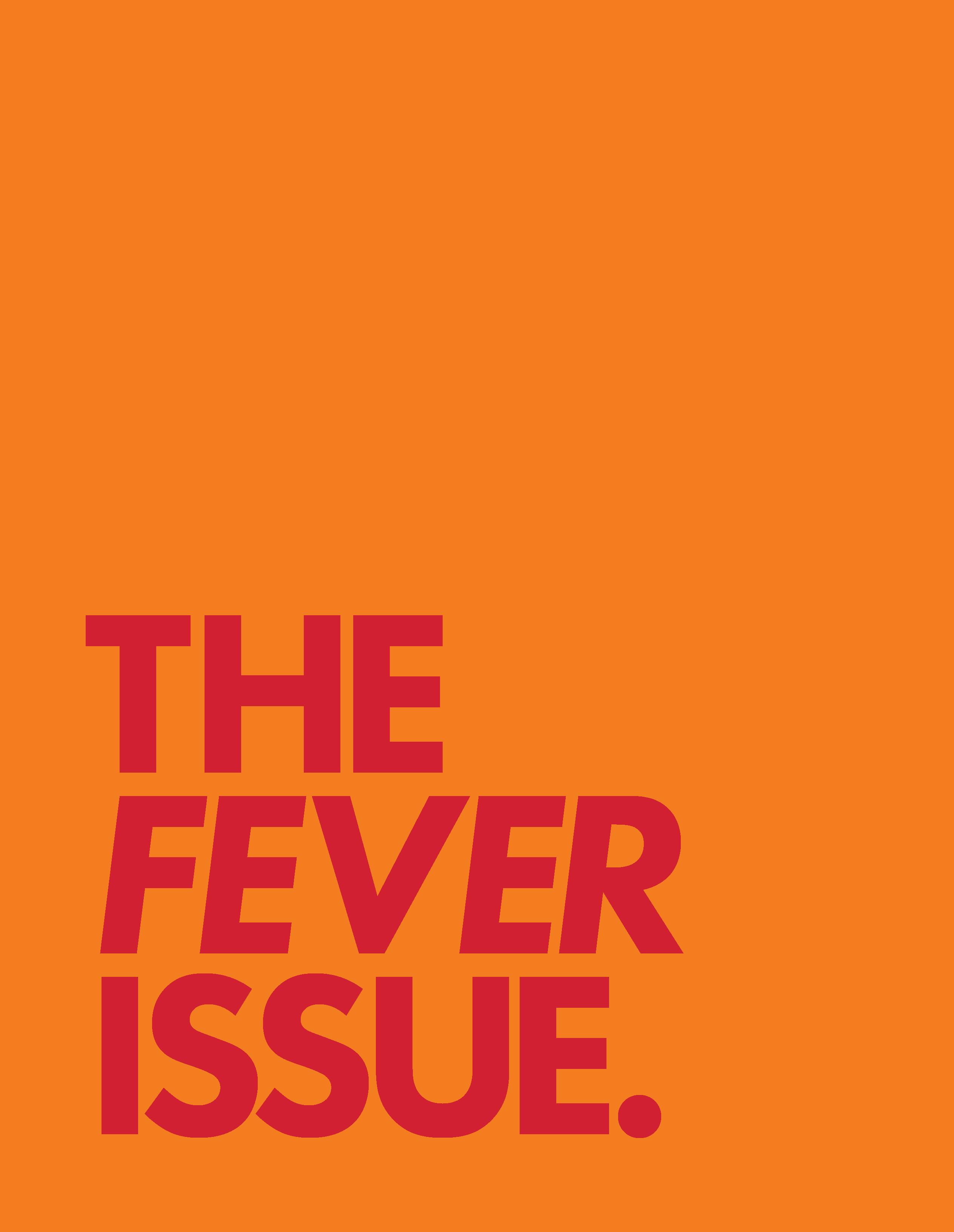






Editor-in-Chief - Amany Khreis
Copy Editor - Amelia Zollner
Art Director - Keeley Flynn
Print Layout - Tim Sands
Albums Editor - Elizabeth Walsh
Concerts Editor - Arthur Machado
Features Editor - Saffron Mears
Photo Editor - Claudia Chan
Social Media Director - Caleigh Parsons Web Director - Quentin Holle
Writers:
Amany Khreis
Amelia Zollner
Arthur Machado
Athena Kafkas
Britta Wellenstein
Caleigh Parsons
Carter Ewen
Elizabeth Kallies
Elizabeth Walsh
Logan Underwood Mia Weisfeld
Quentin Holle Riley Younger
Ryan Gwyn
Saffron Mears
Sophia McGaff
Weronika Durachta
Indigo De Souza
Art: Claudia Chan Keeley Flynn Elizabeth Kallies Caleigh Parsons Tim Sands Riley Younger
Photography:
Amany Khreis
Claire Borgelt Claudia Chan Rory Sterling
In between high moments and low ones, the coldest days of winter and the stinging burns of summer, the loneliest walks and the most crowded parties, everything can blur into one fever I can’t sweat. This feeling isn’t just mine. The past few years have been claustrophobic and restless for us all. This year specifically has been about making up for lost time.
With EMMIE, I didn’t want to waste time. This issue has been months in the making, since way back in March, be fore I knew I would be in the position of editor-in-chief. I was sending emails, making arrangements and setting up interviews with some of my favorite artists of all time.
I spoke to Indigo De Souza about the frenzy of touring and her upcoming plans for the next year. I spoke to Tomber lin about the making of her latest album, i don’t know who needs to hear this... My dear friend, roommate and albums editor Elizabeth Walsh spoke with Mannequin Pussy about friendship and catharsis in anger. My cowork er-in-crime and concerts editor, Arthur Machado, spoke with MICHELLE about their artistic process and rise to fame. Copy editor Amelia Zollner, my right hand man and the person I look up to, had a conversation with Momma about their muses and becoming a “household name.” It’s clear from all these interviews that we’ve all been entangled in the frenzy of this year in the same way. And even in the ways that we differ, we’re still the same.
I am eternally grateful to my editorial board for helping me bring the Fever Issue to life. Without every person on my team, the magazine you’re holding in your hands right now wouldn’t be there. I especially want to thank Claudia Chan, Caleigh Parsons, Keeley Flynn and Tim Sands for being such talented and dedicated artists. Every Saturday morning, Sunday and Monday night and Wednesday evening was so precious to me because I had the chance to work with such incredible people.
I’m just as grateful to the EMMIE staff for loving music enough to write about it and for being dedicated to our mag azine. Lastly, I’d like to thank Saffron Mears and Camila Trimberger-Ruiz for helping me read through drafts and Claire Wilcox for being part of the initial stages of creating a vision for what this issue would look like.
The Fever Issue finds EMMIE at its most intense: rising and falling, making great revivals, being shut in and being outrageous and eccentric.
Xoxo, Amany Editor-in-ChiefUgly Season is the soundtrack to Mike Hadreas’ awakening as he guides us through the innerworkings and feelings on his body, his queerness and what it means to live. Perfume Genius’ sixth studio album is his most innovative and expansive work yet. The album was composed for The Sun Still Burns Here, a dance piece performed by Kate Wallich and Hadreas. Hadreas’ evolution from songwriter to composer is on full display with Ugly Season.
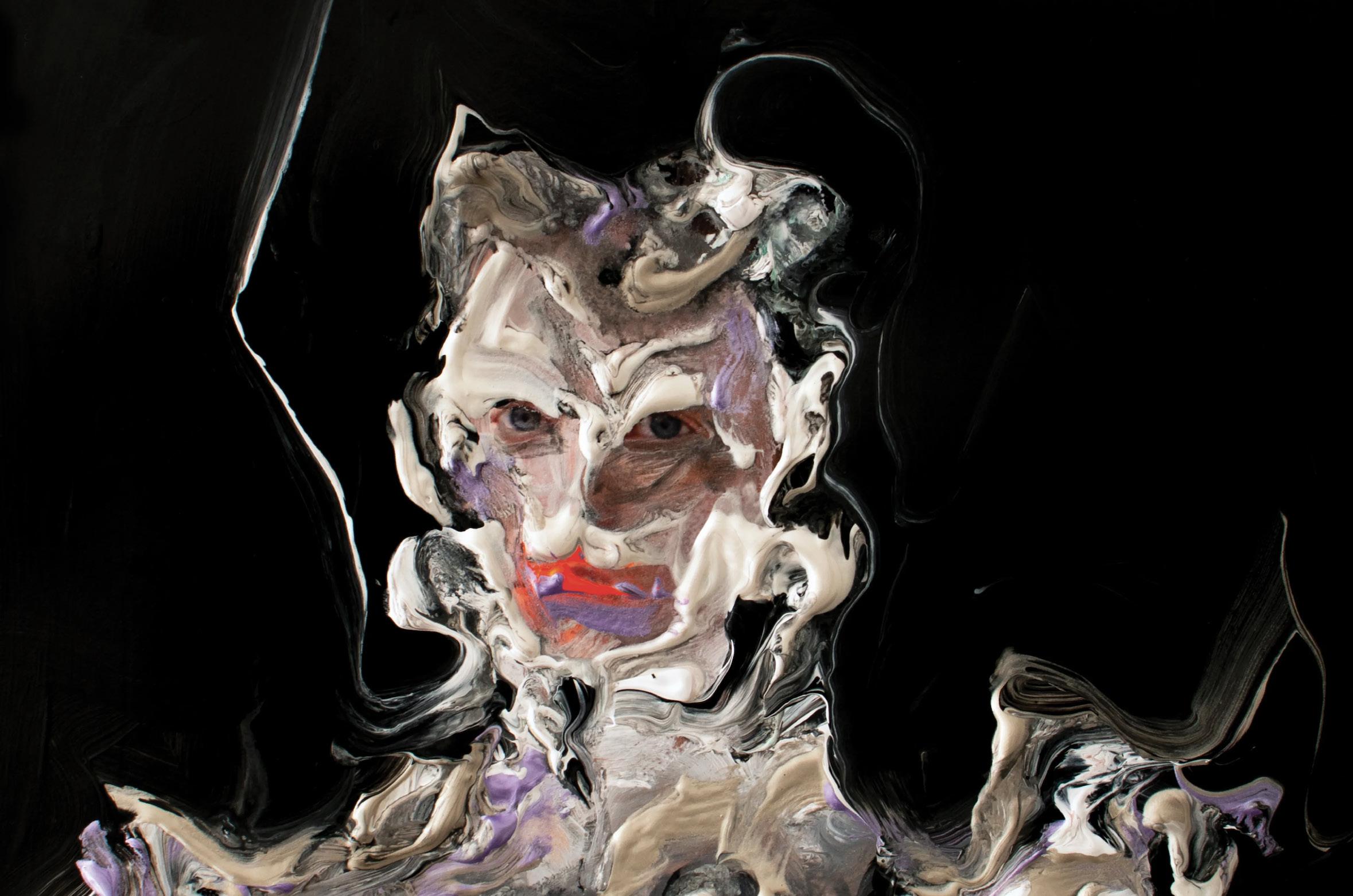
The album opens with “Just a Room” — Hadreas softly draws in his breath and allows the listener to breathe with him. The soft breaths turn into a harsher cry. His wailing is accompanied with deep organ notes, a blissful harp and windlike instrument noises. The whole album varies in music style but carries the whimsical and painfully beautiful tone of desire and love.
Hadreas grew up facing the challenges of being openly queer in the ‘80s and ‘90s, which serves as an inspiration for a lot of his work. He took time to understand what he wanted to create and how he wanted to express these feelings of desire and love. What makes Perfume Genius’ music feel transcendent is the fact that the lyrics aren’t guiding the listener, the melody is.
Most songs on the album are sung in falsetto and carry the vibe of stretching and pushing boundaries. Hadreas lyrically matches this when he talks about extending his body into a fluid being. He sings, “Our body is stretched / And holding one breath.” The intertwined melodies of various wind instruments in songs like “Herem” and “Teeth” twist together like vines, furthering the human connection to nature.
Ugly Season is poetic in its own right and carries multiple motifs throughout the album. In the song “Herem” he uses a raw tone, singing lyrics like “Cosmas stretched out like a reed,” and later in the song “Eye in the Wall,” he softly says “Bend like a reed, tell me you need me.” The theme of growing like a plant is not only synonymous with his falsetto tone but also his experience of being queer throughout the expansive dreamscapes of Ugly Season.
The immediate success of her 2019 debut album, BewareoftheDogs, carved out a definitive space for Stella Donnelly in the music scene. The Austra lian singer-songwriter quickly became known for quick-witted lyrics about toxic masculinity and feminism. While tackling the creation of her second album, Flood, she dealt with aspects of songwriting she had never experienced before: fans, expectations and a legacy. However, it is clear Donnelly did not let this sudden burst of notoriety affect her music. She imbues Flood with the same wit and vivacity that made BewareoftheDogs special but turns towards a new level of introspection not present in her previous work. Donnelly, who wrote 43 songs for the album, narrowed it down to 11 tracks brimming with the self-analysis brought on by the isolation of the pandemic.
Flood’s depictions of everyday life sprinkled with insecurity, heartbreak and uncertainty are incredibly effective in connecting to deeper emotions in a way that BewareoftheDogs never did. No song is a better example of Donnelly’s abili ty to mix simplicity and heavy emotions than “How Was Your Day.” While the song is filled with cheery instrumentals, the lyrics detail a struggling relationship where neither person can admit that it is not working: “Never want to be the one to call it off… feels like breaking up,” Donnelly sings. Similarly, the leading track, Lungs, tells the story of a family facing eviction. However, the glum subject matter is offset by Donnelly’s use of groovy instrumentals, like the bouncy percussion that opens the album.
Quieter tracks like “Underwater” and “Move Me,” which tackle domes tic violence and a breakup, are just as fulfilling as her bright tracks. “Oh, mama, it’s getting worse. I take on your anger and hurt,” Donnelly dolefully confesses at the end of “Underwater.” Her transition into pared-down tracks with a simple piano melody and vocals is just as impactful as her tracks with full production. The instrumentation on Flood is lush and unique, paired with Donnelly’s newfound love for the piano. Jaunty uses of brass and jazz offer a distinctly palatable sound that is consistent throughout the album.
Flood’s cohesive sound is perfect for walking through campus, doing the laundry or working on homework. However, this cohesion could quickly turn into repetitiveness, particularly near the end of the tracklist. “Oh My My My” slowly progresses as Donelly drags on notes with sparse piano instrumentation in the background. The penultimate track, “Morning Silence,” is pleasant but otherwise unremarkable. However, the album finishes strongly with “Cold,” a higher energy song about an argument. The track crescendos with a powerful chorus of chants, culminating Flood with an expansive sound that offers a satisfying ending.


Stella Donnelly’s Flood captures the same boldness that made Beware of the Dogs an immediate success while elevating her music with new-found intimacy. Her mixture of introspection, clever lyrics and simple melodies create a cohesive album that is both easy to listen and relate to.
BOAT SONGS BY MJ LENDERMAN WRITTEN BY ELIZABETH WALSH 8/10“Yeah, I love drinking too,” MJ Lenderman sings on “Hang over Game,’’ the opening track of his most recent project, Boat Songs, as he explores the fragility of being human. He’s reopening the debate on whether Michael Jordan had the flu or was actually hungover at the 1997 NBA Finals. The absurdity of the line amidst a story about one of our biggest stars’ weakest moments begins to reveal the main question explored on the album: How do we accept the faults within our selves and others with humor? The seamless pairing of subtle humor and humility throughout Boat Songs is what makes Lenderman and the album truly special.
While this is Lenderman’s third album, it is the first he professionally recorded. Even though he transitioned to the studio, he did not compromise his sound, holding on tight to the disarming conversational tone of his lyrics and the grit in his production that gave him his grainy homemade sound. Boat Songs starts with some serious twang, with “Hangover Game” and “You Have Bought Yourself A Boat” being the most traditional country songs. He begins to toe the line between alt-country and shoegaze with songs like “SUV” and “You Are Every Girl to Me,” where the guitar and drums get heavier and the vocals get more distorted. The album takes turns flipping between country and rock, but regardless of genre, Lenderman continues to examine the cracks in humanity and grapples with loving them.
The sports stories don’t stop with basketball. “TLC Cagematch” explores a heartbreaking story of self-destruction through a WWE fight. “It’s hard to see you fall like that,” Lenderman sings as he uses the gruesome way wrestlers destroy their bodies for entertainment as a metaphor for how people begin to tear themselves apart under the harsh realities of life. The slow, melancholic guitar and vocals on the track makes it feel like I am watching this cagematch unfold in slow motion and cannot stop the harm we are doing to ourselves and others. There is a stark moment of empathy when Lenderman says, “And that’s why we do what we gotta do to get through / And I know life will make us crazy, I do.” Lenderman provides understanding without judgment and shows the listener how to look upon others with compassion.
Lenderman’s real talent is how he never seems to take anything too seriously. Even as he sings about losing control, there is no sense of urgency to get back on track. Everything about the record feels easy. His natural storytelling ability makes the songs feel more like conversations with old friends rather than intentionally written lyrics. The instrumentals evoke a nostalgic country sound that feels comforting rather than an attempt to forge new ground. Lenderman closes the album with “Six Flags,” singing, “No one’s counting your mistakes.” He once again provides comfort and reminds us how the album started: that we all make mistakes, even Michael Jordan, but it’s how we accept our mistakes and move forward that matters.
On her third album LP. 8, Kelly Lee Owens forges new ground. She departs from the more traditional dance beats she previously produced and enters an era of experimentation. It is her most innovative work yet as she challenges the listener, asking them to be an active participant, making them question their place in the work.

Relying on natural sounds and her own voice, Owens creates a new rhythm that steers her away from the bounds of a singular sound and lands in a territory full of abstraction. Owens’ previous work is a fusion of techno and progessive electron ica, which have formed her unique style. LP.8 does not feature the same chord progressions and often avoids instrumental peaks that are commonly found in many electronic subgenres, rather it is a study on Owens’ voice as an instrument where she explores how her vocals create layers of texture. The use of her own voice throughout is intimate and provides the first glimpse into the world she is creating.
In a way, LP.8 isn’t made to necessarily comfort the listener, rather it serves as a work that invites the listener into Owens’ internal world through the use of her own voice. In her opening track, “Release,” Owens focuses on the staggered repetition of the word title word not only as an instrument but also a meditative tool urging the listener to release any tensions trapped inside.
A meditation through her vocals is further explored in “Voice” and “Olga.” A change of pace occurs in “Anadlu,” which still implements the use of her voice, but rather as a supplement instead of the main focus. Here, we also see a longer build up, creating a euphoric sensation often seen in electronica. Though it’s a longer piece, it’s not as repetitive as the other pieces on the album. “Anadlu” is one of the strongest of the album, as it feels more exciting and serves as a peak.
An even larger change in pace is found in “Nana Piano,” which calms the entire album down through the use of a classical piano and delicate, electronic echoes. Though her voice is not found here, again she forms a meditative experience through the use of few climaxes and consistent instrumentation.

Perhaps the only song that tells a clear story is “One.” In comparison to the other songs on her album, “One” uses lyricism to create the story rather than generating emotion through sound. Through this, it really does offer versatility and helps break the album up from solely being instrumental. An intermission, if you will.
Owens is a brilliant artist. Her previous albums clearly demonstrate her versatility as a producer to create works that are exciting and awaken an energy in the listen er. Though LP.8 finds itself on a different path, it’s one that isn’t necessarily worse — it just demands more from the listener. It’s not an easy collection to listen to on your way to class. But that’s the challenge in it.
THE GIRL BY RINA SAWAYAMA WRITTEN BY SAFFRON MEARS5/10
Coming off the immense success of her self-titled debut album SAWAYAMA, it is clear that singer Rina Sawayama felt she had something to prove.
On the heels of dueting with legends such as Elton John on “Chosen Family” and Lady Gaga on a remix of “Free Woman,” Sawayama had a lot of pressure to release another pop hit. And she did — almost. In her sophomore album, Sawayama uses Hold the Girl to tell a personal story of childhood trauma and queer identity through a pop-punk collection littered with religious innuendos.
British-Japanese popstar Rina Sawayama found the album title Hold the Girl through a phrase she learned in therapy. A sentiment of healing and therapeutic release is evident throughout the album, with tracks ranging in a rollercoaster of emotions and tempos. In the title track, Sawayama begins with a gospel-like reverbed choir and heavenly vocals, using religious undertones as the basis of her message. As the pop beat builds, the familiar phrase “hold the girl” is repeated in the background. Sawayama pens this song as a personal story of heal ing, trauma, and her ability to eventually comfort her younger self. As the techno beat swells, Sawayama states, “She is me and I am her.”
Hold the Girl continues with grittier, more underground pieces like “Imagining” and “Frankenstein.” Reminiscent of Lady Gaga and Avril Lavigne’s early work, Sawayama channels the essence of a bold punk diva through pounding beats and raging vocals.
Following the overwhelming success of her first album, SAWAYAMA, listeners anxiously waited to see what Sawayama would release next. As singles like “This Hell” and “Hold the Girl” were released, opinions remained optimistic that Sawayama would continue to produce only experimental pop excellence. Tracks like the emotional power ballad “Forgiveness” and the opening introspective piece “Minor Feelings” give the album weight and build Sawayama’s narrative. Through this album, she looks to mend her broken pieces and fully accept herself while also uplifting other queer individuals. The techno track “Holy (Til You Let Me Go)” explores identity and religious trauma through an intoxicating ballroom beat and powerful vocals to create a righteous queer anthem.
The album begins to lose structure in the second half, with jarring transitions between tracks of hair metal rock like “This Hell” and Shania Twain-like pop country pieces such as “Catch Me In The Air.” I found myself enjoying Hold the Girl more separately than as a collection. The album’s flow feels disjointed at best. It does not allow the listener to fully appreciate Sawayama’s message of inclusiv ity and healing, and it lacks the experimental aspects that were so prominent in SAWAYAMA.
Hold the Girl is Sawayama’s ode to personal growth from past hard ships. Memorable tracks utilize underground techno and house beats while also highlighting Sawayama’s impressive vocal range. The album begins to lose strength as transitions between tracks felt fragmented and forgettable, letting Hold the Girl as a whole swallow its few strong tracks.
Listening to Alabama-based musician, filmmaker and producer Ethel Cain’s sophomore album Preacher’s Daughter, one cannot help but be transported instantly into the visual landscape of the Southern Gothic. The album follows Cain from her upbringing as a preacher’s daughter in Alabama to her journey through the American west, and her eventual ascension to heaven. Arranging the 13 tracks like a screenplay, Cain’s meticulously constructed narrative draws heavily on her personal experience. She dissects concepts of familial abuse, generational trauma, religion and forgiveness through confessional lyricism and atmospheric instrumen tals. In an interview with Alternative Press, Cain remarked: “Everything I do through my art is a way to get my thumb on top of what’s happened to me in the past, because now I’m in control and I can’t be hurt by it again.” Preacher’s Daughter undoubtedly speaks to this theme of reclamation, creating a parallel narrative to Cain’s personal experience as a trans woman and the daughter of a Southern Baptist preacher.
The first act of Preacher’s Daughter opens with distorted audio of a church sermon, laying out grotesque religious imagery onto a reverb-heavy instru mental canvas. Beginning with the doomed tale of Ethel Cain, “Family Tree (Intro)” sets the tone for the rest of the album and foreshadows a gruesome end. With the atmospheric groundwork set, the following track “American Teenager” presents the only significant weakness of the record. Discussing the unattainable figment of the American Dream, the song plays more like a top 40 pop hit rather than a track on a brooding concept album. While definitely catchy, its stark contrast to the rest of the record takes away from the aesthetic continuity that makes Preacher’s Daughter
so hypnotically captivating.
As the record progresses, Cain begins to lose herself to drugs and her abusive partner. The energy builds to a breaking point and arguably the most conceptually impressive track on the record: “Ptolemaea.” Cloaked in a looming haze, reminiscent of slowcore and horror soundtracks, the hallucinating Ethel meets a gruesome end at the hands of her lover. With lyrics that read like an impassioned Baptist sermon or a deranged rambling of a cult leader, “Ptolemaea” creates a listening experience that is decidedly horrific. The track showcases Cain’s ability to craft a blisteringly intense atmosphere and utilize the language and imagery of her past as a cathartic processing space.
Coming down from the grisly high of “Ptolemaea,” the final tracks of Preacher’s Daughter dissolve into the minimal, stripped-back beauty of Cain’s more ambient tendencies. As the culmination of the record’s narrative, “Sun Bleached Flies” follows Cain as she forgives those who have hurt her and attempts to find so lace in a religion that has deliberately excluded and dehumanized her. In the third and final act of her gothic epic, Cain is able to acknowledge, forgive and ultimately ascend. As this chapter of her saga comes to an end, Cain has already hinted at a continuation record, leaving listeners waiting eagerly for the next installment in her cinematic universe.

 WRITTEN BY CALEIGH PARSONS 9.5/10
WRITTEN BY CALEIGH PARSONS 9.5/10
Alex G is praying for you, whatever that means. On his ninth album, God Save The Animals, producer and singer-songwriter Alex Giannascoli is simultaneously at his most open and his most conflicted. Giannascoli’s sound is more expansive than ever before, stretching across 13 diverse but consistently well-crafted songs. While known for his DIY musical process, the album now finds him working with several sound engineers for the first time. Familiar collaborators, including violinist Molly Germer and co-producer Jacob Portrait of Unknown Mortal Orchestra, help to build the album’s richly textured sound.
In many ways, the album recalls the wonderfully weird imprecision of 2019’s House of Sugar. But where its predecessor occasionally meanders into unfocused, God Save The Animals makes room to explore without forging new ground entirely. The straightforward sound complements the themes of the early tracks as Giannascoli sings of sticking to the mission and sets the stage to ask the big questions that his lyrics might have sidestepped in the past.
Giannascoli is a master at distilling a complex, ambiguous sentiment into a simple image. He creates space for questions while acknowledging that their answers remain elusive. He finds comfort within the familiar — coming home to reruns on TV or reaching for cigarettes on an anxious morning. God is an image, too: a device with fluctuating meanings rather than a figure with a definite presence. Within the confines of the album, simple ideas like caring for someone or praying for the animals feel like revelations. They aren’t answers, but they’re enough all the same.
That’s not to say that the album is without its tricks. In “No Bitterness,” a briefly chaotic Autotuned breakdown hits like a shot of adrenaline. In the reassuring ballad “Cross The Sea,” Giannascoli proclaims, “You can believe in me,” until the foreboding drone of a blaring synth transitions into the unforgettable curveball that is “Blessing.” Its militaristic drums and gritty bassline create a backdrop for a whispered prayer: “If I live like the fishes / I will rise from the flood.” This self-as surance soon turns into restlessness (“Haven’t I given enough? / When will I run out of love?”) on “Early Morning Waiting.” The album finds its footing in these middle tracks, somewhere in the midst of control and chaos or faith and doubt. Sonically diverse but linked together, they remind listeners that Alex G is still an experimenter at heart.
In the past, many of Alex G’s songs were self-contained worlds driven by elusive characters. Here, Alex sets aside the Sarahs and Sandys of past albums in favor of a direct exploration of introspective themes, without being overtly confessional. The penultimate track, “Miracles” feels like the synthesis of the album’s ideas as he asks its final question: “How many songs am I supposed to write / Before I can turn it off and say goodnight?”
Although it’s hard not to read many of the lyrics as literal references to his musical career and personal life, Giannascoli remains primarily concerned with themes beyond himself, proclaiming “No stories / no mirrors” on the raw, hopeful album closer “Forgive.” It’s not a decisive ending, but Alex G is a pro at depicting the indefinite. Pulled taut between opposing forces, God Save The Animals shapes up to be his most cohesive album yet.
WHILE OF UNSOUND MIND, nouns’ first full length LP since 2014 and first independent release, is the album that bandleader and sole original member Hunter Clifton Mann has always wanted to make, according to the group’s Band camp page.

Free from the influence of a record label and Mann’s original band mates, all of whom have departed since their last album, nouns has become a new band in all ways but name. WHILE OF UNSOUND MIND fully embraces an experimental rock style that can only be explained as chaotic. It departs from the sound that they crafted on their previous LPs, still bummed and still, which leaned into an indie rock and midwest emo sound.
The production on this album is wildly varied, filled with unorthodox instrumentation — including databending (a style of audio distortion achieved by editing sound files in a notepad application), the cajón (a box-shaped drum, usu ally found within Latin music) and the flutophone (a recorder-adjacent flute, often found within elementary school music rooms).
The screamo delivery, paired with heavy compression and distortion, makes the lyrics extremely indecipherable and takes away from the excellent production at points, most notably on “FEEDBACK LOOPS.” However, this style of vocals works on some tracks, like “MAROMI” and “LEMURIAN HYPERSTITION,” where they serve more as accompaniment to the instrumental rather than a sepa rate entity.
WHILE OF UNSOUND MIND reaches its peak on the ten minute long track “LEMURIAN HYPERSTITION.” The song opens to the sampled rhythmic whirrs of old electrical equipment, simple piano riffs and guitar chords which build into my favorite instrumental on the album. Pitch-corrected dial-up modem, bitcrushed guitar and electric organ ramp up in noise, speed and intensity for a few minutes until the cacophony of sounds fades out. Replacing the noise are discordant violin stabs and racing drums, which create an ethereal and violent sound. In the last few minutes of the track, the style of the song changes once again; the racing instrumental is replaced by a calm and harmonious Moog synthesizer and chanting vocals which disappear into a sea of noise.
WHILE OF UNSOUND MIND is certainly an acquired taste, but for those in love with experimental rock, from black midi to Parannoul (who appears on “AMITA DRIVE”), this may be their album of the year.
Since 2013, Bladee and Ecco2k of the creative collective Drain Gang have been the de facto rulers of the chronically online music community. They have a reputation for quirkiness and have committed a good portion of their lives to venting about their predicaments in the most random metaphors possible. This year, the duo released Crest, a glittery pop effort that’s just as goofy as it is thought-provoking. Joining this project as producer is longtime collaborator and fellow Drain Gang member Whitearmor. His consistency and ability to find new sounds and techniques makes him possibly the most underappreciated and impactful creative in the Euro pean underground.
For nearly a decade, the members of Drain Gang have been toeing the line of androgyny. For this album rollout, instead of doing traditional leaks and social media posts, they partook in fashion collabs and art shows with sexuality at the forefront and began embracing outright femininity. This is highlighted early on by “Girls Just Want to Have Fun,” the album’s lead single,with its bouncing beat and effervescent vocals. Nowhere is gender more blatantly disregarded than on “The Flag is Raised,” with lines “I’m but a shell, baby, the hero is the soul / Keep it within you, continue in you.” Accompanied by the heavenly imagery throughout the song, the line depicts a paradise where gender, and the social constructs that come with it, are discarded.
In a time of political upheaval and uncertainty, Beyoncé’s Renaissance is a shining light, uplifting our spirits and propelling us toward the dance floor. The dance album is dedicated to her late uncle, who introduced her to the ballroom scene and fostered her love for music.
The ballroom scene is a largely Black and Hispanic LGBTQ+ subculture that began in New York in the ‘60s. House and dance music is a staple of ballroom culture, where the participants strut down runways, voguing and competing for titles in different categories.
This high-energy album perfectly encapsulates the vitality of ballroom culture. “ALIEN SUPERSTAR” is where Beyoncé gives her biggest nod to ballroom, singing out her own categories like “Bad Bitch” and “Sexy Bitch,” and saying “I’m the bar,” letting the listener know she is taking home the prize. Her songs push mantras of confidence and comfortability with your identity, singing, “Comfortable in my skin / Feet up above your sins / I love myself, goddamn” in “COZY.”
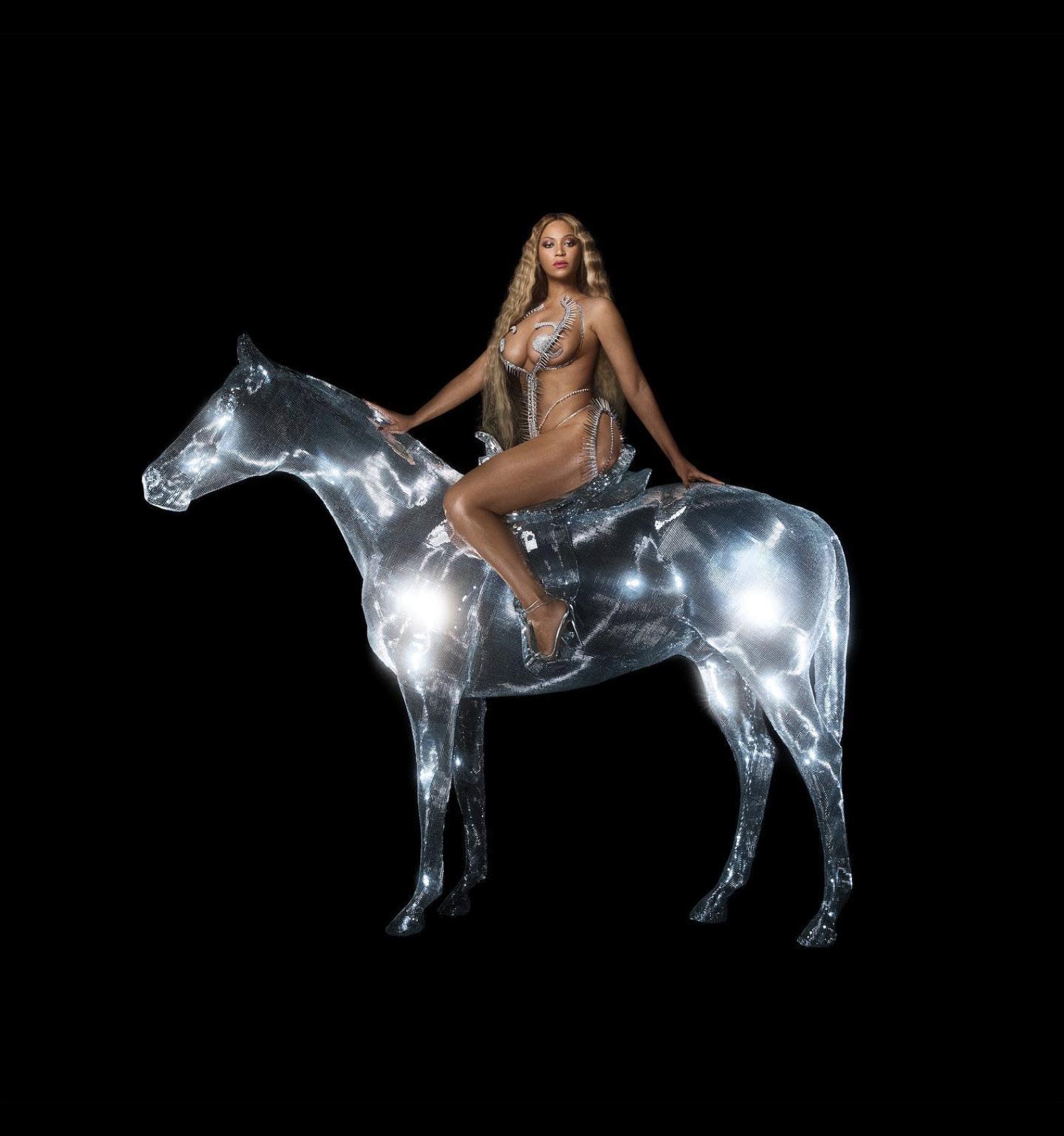
Not only did Beyoncé derive influence from ballroom culture, but she also tied in a plethora of elements from popular culture. Renaissance serves as a perfect piece of work that signifies her cultural and artistic rebirth. Remixing and re working classic house, R&B, hip-hop and pop songs, such as “Milkshake” by Kelis, “I’m Too Sexy” by Right Said Fred and “Show Me Love” by Robin S, this album gives way to incredibly creative cross-genre collaborations and unique sampling choices. This album is truly at the nexus of underground and mainstream culture, complementing each other to build a sonically impactful album.
The components of disco, house, rap, and R&B vocals all center around lyrics about love, having fun and being comfortable with yourself. The apex of all of these elements lies within the song “BREAK MY SOUL,” released as a single in June, making it one of the most popular songs of the summer as well as alluding to the astronomically huge influence of her upcoming album.

Beyoncé inspires confidence within the listener and encourages them to get up and dance with songs like “CUFF IT,” “VIRGO’S GROOVE,” and “SUMMER RENAISSANCE.” These tracks are heavily reminiscent of the ‘70s disco era, with elements like lively basslines, stunning harmonies, futuristic synths, massive kick drums and the classic Beyoncé hi-hat.
Social media platforms like TikTok only further elevated the success and created trends with her songs encouraging people to dance with each other. Overall, Renaissance lives up to its name, as it created a cultural revival of shamelessly loving yourself and feeling confident in your skin.
The everpresent tone across the album is one of existentialism blended with a sense of childlike wonder that manages to not come across as ignorance. In “Desire is a Trap,” Bladee delivers the principal line, “Pick petals from your flowers / Oh you love me oh you love me not,” where he uses a childhood game to display his conflicting feelings of love and hopelessness. The line is again referenced by both Bladee and Ecco2k in their following verses, each taking a different approach. Bladee embraces the unknown and finds comfort in the control he has over his future, while Ecco2k can’t escape the monotony and falls deeper into the void. The varied lyrical content is highlighted by the trisection of hyperpop, cloud rap and plugnb throughout the album and sometimes within the same song. Whitearmor earns his keep as producer by varying the beats and song structure in the same trajectory as the lyrics, especially on the tracks “White Meadow” and “5 Star Crest (4 Vattenrum),” where each beat switch brings a new emotion without overpower ing the vocals and lyrics.
The track “Chaos Follows” best represents the album as a whole, play ing as a conversation between Bladee, Ecco2k and a higher power. They are both discontent with life and wondering how to carry on with problems encompassing everything from self identity to the perceptions of greater society. Through all the bouncing lyrics and sounds, the album coalesces into an epic about egoism and spiritual beauty, reminding us that whatever we choose to measure the fullness of life with, it must be independent of our social identities.

 WRITTEN BY QUENTIN HOLLE AND RYAN GWYN
WRITTEN BY QUENTIN HOLLE AND RYAN GWYN
Born out of sweaty NYC and Philadelphia clubs, no genre of music enthralled the United States as much as disco did during the late 1970s. Disco was the music of the people. Unlike rock, disco defied the stereotypes of the era, allowing every in dividual — specifically, Black, Latine and queer folk — to freely express themselves. Donna Summer had a hit in 1977 with the Giorgio Moroder-produced track “I Feel Love,” which focused on her sexuality as a woman. The gay disco group The Village People frequented the top of the charts with tracks including “Macho Man” and “YMCA.”
In late 1977, disco hit the mainstream following the release of “Saturday Night Fever”, which pushed the subculture out of underground clubs and onto the big screen. Included on the LP were disco classics including the Bee Gees’ “Stayin’ Alive” and “Night Fever” and KC & The Sunshine Band’s “Boogie Shoes,” among countless other hits. Perhaps the most interesting additions to the soundtrack were eccentric disco reinterpretations of classical tracks — “Night on Disco Mountain,” David Shire’s take on a Russian composition from the late 1800s, and Walter Murphy’s “A Fifth of Beethoven,” a track adapted from the first movement of Ludwig van Beethoven’s “Symphony No. 5.” After “Saturday Night Fever”, disco became a craze.
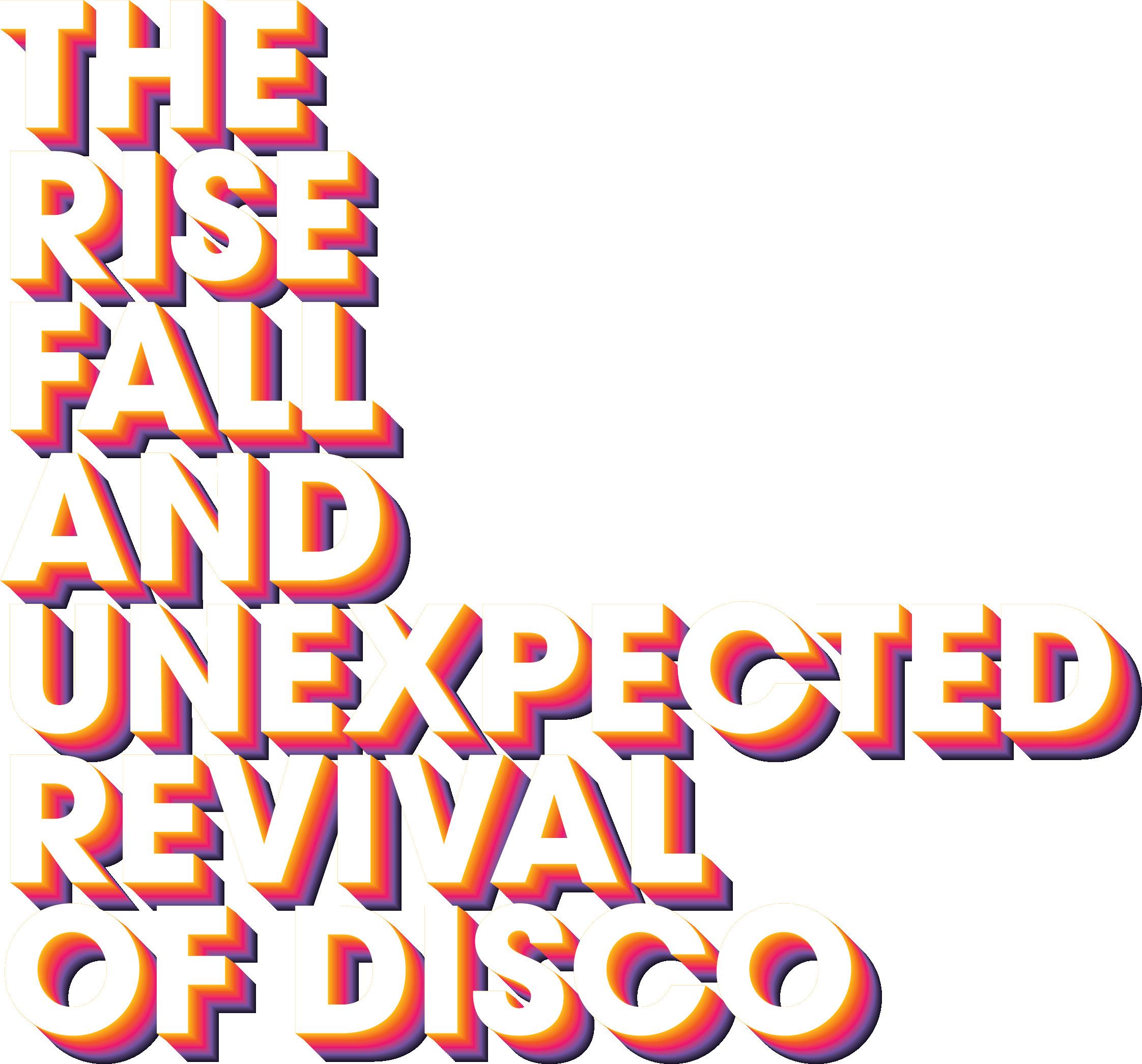
Disco had finally become mainstream, and nearly every artist in the era had to cash in on the trend. On Pink Floyd’s The Wall, the traditionally prog-rock group used disco drum patterns and Nile-Rodgers-esque guitar riffs on their track “An other Brick in the Wall.” KISS unexpectedly jumped into disco with “I Was Made for Lovin’ You” in 1979. Following the lead of Walter Murphy and David Shire’s attempts to turn non-disco tracks into disco, the band Meco reached the top of the Billboard Hot 100 with their reworking of the Star Wars soundtrack on “Star Wars Theme/Cantina Band.” Even Sesame Street had to dip its toes into disco with two albums — Sesame Street Fever and the follow-up Sesame Disco!, having been released in 1978 and 1979 respectively.
While a lot of disco has aged poorly, some songs have stood the test of time. With their tight guitar riffs, catchy syncopated basslines, sharp horns and danceable four-on-the-floor beats, Nile Rogers and Bernard Edwards of Chic were the gods of disco, creating timeless tracks including “Good Times,” “My Forbidden Lover,” Sister Sledge’s “He’s the Greatest Dancer’’ and “Upside Down” with Diana Ross. Cheryl Lynn hit number one on the Hot Soul Singles chart in early 1979 with “Got to Be Real.” Reaching number four on the Billboard charts was George Benson’s disco hit “Give Me the Night.” In early 1978, WKTU, a low-rated radio station in New York switched from rock to disco and became the most popular radio station
in the United States nearly overnight. Disco had reached its peak. Disco was not without its opponents, however. Over in Chicago, a rock radio host by the name of Steve Dahl was fired on Christmas Eve of 1978 as part of his station’s transition from rock to disco. Three months later, Dahl was hired by a rival Chicago station, WLUP. He began his crusade against disco music with a series of stunts, rallying Chicago’s rock fans together. Dahl mocked disco on air, calling his past station, WDAI, “Disco-D.I.E,” mocking WDAI’s slogan “Disco-D.A.I.” He recorded a parody of Rod Stewart’s “Da Ya Think I’m Sexy?” called “Do You Think I’m Disco?” which managed to chart on the Billboard Top 100, peaking at 58 on the charts. When disco star Van McCoy, the artist behind “The Hustle,” suddenly passed away, Dahl celebrated by destroying the track live on air. He encouraged his listeners to invade discotheques across the Chicagoland area and cause disrup tion.
Over time, Dahl and his associates gained so much popularity that they managed to draw the attention of Chicago White Sox owner Bill Veeck, who was infamous within the baseball world for his odd promotions. Amidst a weak White Sox season with middling attendance, Dahl worked with Veeck to concoct the perfect promo tion: attendants of the game would get 98 cent tickets if they brought in a disco record to be destroyed. Between the games of a doubleheader, Dahl would travel to the field and use explosives to blow up the records that they received, broadcasting it live on air.
The promotion was immediately a disaster. Not expecting there to be so many people at the stadium, collection bins quickly overflowed and vinyl stopped being collected. Fans responded to this by throwing their uncollected records from their upper-deck seats onto the field like frisbees. People began to jump turnstiles, enter open windows and climb fences to make their way into the park. Somehow, despite the rapid onslaught of LPs and whatever else the audience could get their hands on, including firecrackers and glass beer bottles, the first game managed to be played in full.
After the first game ended, Dahl entered the field to chants of “disco sucks.” Dressed in an army uniform and combat helmet, he traveled to the massive crate of disco LPs and addressed the crowd: “This is now officially the world’s largest anti-disco rally! Now listen — we took all the disco records you brought tonight, we got ‘em in a giant box, and we’re gonna blow ‘em up reeeeal good.”
Dahl detonated the records, leaving only a large hole in the outfield where the bin of vinyl once stood. Some 5,000-7,000 fans rushed the field as White Sox and Detroit Tigers players raced to barricade themselves inside their dugouts. The field was littered with vinyl and styrene shards. A bonfire raged in center field.
It may be a bit hyperbolic to say that Disco Demolition Night was what killed disco, but the event signaled a rising anti-disco sentiment in America. To those who hated it, disco went against conservative, traditional hegemonic ideas and needed to be vanquished. Following the event, disco rapidly fell from glory, dropping off of the charts and subsequently out of radio.
The disco sound laid somewhat dormant for several decades. However, in the early 2010s, an awakening began. The revival of disco has steadily grown in support in the past 10 years and is today once again omnipresent in pop and dance music. Its influence is so apparent that the sound has been dubbed “nu-disco.”
Over time, fans and producers alike began to recognize a space for the “groove” to return, and the stage was set. While the nu-disco movement brewed for some time in the French house movement of the ‘90s, the sound truly hit the charts with Kylie Minogue’s aptly named 2001 album Fever.
Today’s disco obsession story is well framed by the breakthrough story of Daft Punk’s 2013 hit “Get Lucky,” alongside Pharrell Williams and Nile Rogers. To an unsuspecting listener, this record almost feels stolen from the ‘70s. Bolstered by pin point modern production techniques, the lush vocal harmonies and snappy guitar and bass parts pay homage to the disco greats and it worked. “Get Lucky” quickly became Daft Punk’s highest charting record, peaking at #2 on the Billboard Hot 100 in 2013. Throughout the rest of the 2010s, nu-disco-inspired records infiltrated the pop music scene. Whether it be the tight, funky guitar on Taylor Swift’s “Style” or the snappy drum grooves in LCD Soundsystem’s ThisIsHappening, disco was alive and well.
While disco’s instrumentation and sound had been seeping into mainstream pop, the sound leaped into the EDM world at an internationally recognized level with the release of Calvin Harris’s album Funk Wav. Bounces Vol. 1. This record was entirely unprecedented from an artist synonymous with main-stage progressive house clas sics, the likes of “Feel So Close.” Lesser-known house artists had been establishing themselves with a disco-oriented sound for years, but no EDM icon other than Daft Punk had ventured into the space before Harris. The record carved a unique niche in the nu-disco space: it combined a growing nu-disco style with modern electronic instrumentation, and a star-studded cast of the hottest acts in hip-hop at the time:
Travis Scott, Migos, Frank Ocean and Pharrell Williams, to name a few.
Today, we’re in the process of entering an entirely new stage of the disco revival. Remember those niche house acts of the 2010s? They’re going mainstream. Big time. House music has been around since the late ‘80s and was arguably born out of the disco boogies of the ‘70s. This being said, house music that incorporates disco instrumentation and actual samples from ‘70s disco has long flown under the radar until recently. One of the modern pioneers of this sound is German producer and DJ Tio Piontek, known by the alias Purple Disco Machine. His music relies assertively on disco, funk and soul elements, bound by a modern house and techno blueprint. Piontek is an important figure in the story of disco house, as his music is emblematic of how the disco sound fits so soundly into the structure of house music. In fact, the cowbell and bass pattern from his 2017 track “Body Funk” could very well have been pulled straight from Lipps Inc.’s 1979 disco classic, “Funkytown.”
Arguably one the most successful dance records of 2022; British dance duo LF System’s “Afraid to Feel’’ is one of the best examples of the modern disco edit. This is a term that dates back to the ‘70s, used to describe early DJs mixing a popular song with disco instrumentation in order to jumpstart a club dance floor. The song samples vocals from ‘70s soul act Silk’s song “I Can’t Stop (Turning You On),” an original that in no way meets the criteria for disco.
With the help of a little tempo boost, booming drums and swinging hats, a nu-disco house track is born. A tasteful sampling of ‘70s disco and soul is becoming a key ingredient in dance music in 2022: Oliver Heldens’s modern twist on Chic’s “Le Freak,’’ L’tric’s rework of Marvin Gaye’s “Sunny” and British house act Joshwa’s sampling of The The Jackson Sisters’ “I Believe In Miracles’’ are just a few that come to mind.
While the mirrored balls, flared jeans and reflective jumpsuits may have been left in the late ‘70s, the idea that “disco is dead” is simply untrue. In fact, the genre is more relevant than ever. While its influence has popped in and out of the charts over the years, disco’s rich history and sound is a fever that was never quite meant to go away. Beyond the bouncy bass lines and foot-tapping drum grooves, disco music, old and new, is a friendly reminder to grab a partner, hit the dance floor and boogie as hard and as feverishly as possible.



In late 2006, Wisconsin native Justin Vernon retreated back to his home state following the breakup of his band and the end of a relationship in North Carolina. Vernon stayed in a cabin in Dunn County, Wisconsin, hoping the winter of isolation would aid in emotional recuperation. Despite aiming for complete respite, Vernon found himself unable to sit idle in solitude. He began playing wordless melodies on various instruments. He then penned lyrics that matched the “feeling” of each song as he replayed the music over and over — capturing his own recovery and emotional catharsis in song.
For Emma, Forever Ago was released by Vernon in 2007 under the artist name Bon Iver to both commercial and critical acclaim, cementing the folk artist and his Walden-esque cabin retreat as indie legends. Yet, as romanticized stories about Vernon hunting for his own food and spending upwards of 14 hours at a time producing songs circulated as a testament to his artistic commitment, the truth got buried in all the surrounding noise.
Vernon never planned on writing music. The experience of being in the cabin didn’t feel monumentally ingenious to him. The truth was that 25-year-old Vernon felt lost. He was escaping the confines of paying bills and working a job in a sandwich shop, trying to figure out who he was while battling the anhedonia that came with his depression. In his own words, Vernon’s time at the cabin was one where he simply “plugged in a laptop and fucked around.”
The overt romanticization of the production of For Emma, Forever Ago can be attributed to its popularity, the deep resonance it struck with listeners as it covered themes of mediocrity, entrapment and longing. Vernon’s introspective lyrics felt like hearing a series of private confessionals, the kinds of conversations you can only have in the safety of one’s home.
Understanding the profound intimacy that came from his self-production, Vernon stayed in Wisconsin for the creation of Bon Iver’s second record. Remodeling a studio from a defunct swimming pool and veterinary clinic with his brother in Fall Creek Wisconsin, Vernon continued to invite listeners home.
While traditionally associated with a folk sound similar to Bon Iver, “cabin albums” are not limited to a particular genre or time period. Artists such as The Rolling Stones and Bon Iver’s influence Bruce Springsteen are both credited with creating albums in their homes. Additionally, with the rise of GarageBand, streaming ser vices and social media, artists have newfound increased accessibility when it comes to music-making.
Genres such as bedroom pop rose in popularity in 2016, when blooming sing er-songwriters began releasing homemade tracks from their apartments and dorm rooms — music that was nostalgic, deeply vulnerable and felt more “personal” than studio records. These tracks were relatable due in part to the emphasis placed on lyrical composition over studio production elements. They remind us that, at the end of the day, music has the capacity to serve as a sort of artistic catharsis — to capture feelings such a love, loss, longing, restlessness, anger and confusion to then share them with a distant audience.
When the world first shut down in March of 2020, the pandemic prompted us all to step inwards physically, and soon — emotionally. The unprecedented period of isolation forced us all to step away from our occupations, social interactions and experiences from which we formed our own identities. We started using words like “unprecedented” and “uncertain.” We felt this uncertainty as we all began to reckon with deep-seated emotions that day-to-day business was really good at distracting us from.
What was unique about the pandemic was its imposed universality — it served as an equalizer when all artists were confined to their bedrooms and forced to grap ple with loss and loneliness. During this time of widespread cabin fever, industry giants and aspiring artists alike were compelled by circumstance to blur the bound aries between music as a therapeutic release and as an occupation. By imposing physical restraint, many musicians began reverting back to more simplistic styles of composition similar to Bon Iver and the bedroom pop artists of 2016 — they began writing in isolation and working in solitude. In doing so, they created deeply introspective records, further popularizing a precedent (and pushing the potentials) of homemade production that follows musicians today.
Notably, industry giant Taylor Swift transitioned into mimicking a cabin fever album (and even collaborating with Bon Iver) with the releases of folklore and evermore in the first year of lockdown. The sister albums were produced mainly in Long Pond Studios, a cabin in Hudson Valley, New York. folklore details trying to carry forward through conflict and evermore focuses on pain and closure. What’s beau tiful about the sister albums, as Swift refers to them, is how she utilizes music as a process rather than a product.
And Swift is not alone. Following the cancellation of Big Thief’s tour as a result of COVID and the aftermath of a breakup, lead vocalist Adrianne Lenker retreated to a one-room cabin in Westhampton, Massachusetts. Similar to 2006 Vernon, Lenker did not plan on making music. Even so, she soon found herself writing. With nine of the eleven total tracks in songs composed in cabin sessions, the album feels like an immersive walk in the forest—you can hear the rain, birds and Lenker’s recur ring motif of yearning to have somebody to share the experience with—she keeps calling out to hold your hand.
In the constraints of a pandemic, longing for connection is nothing new. Yet, what’s so powerful about music is that it transcends physical boundaries; connecting listen ers across space. Lenker’s lyricism brings listeners to her, allows them to experience with her.
Taking the experience one step further is Charli XCX, who impressively managed to create an album in her bedroom in six weeks. An experimental product of self-isolation, HowI’mFeelingNow takes desiring closeness in a time of isolation in another direction — one of physical yearning.
During production, she reached out to her fans via Zoom and live streams and relied on fanart for single covers, trying her best to connect with people and share her work as she went. The result was a project that was inspiringly optimistic—cov ering themes of sexuality, intimacy and desire.
Forced into isolation, the cabin fever experienced by Swift, Lenker and Charli XCX differs from that of Bon Iver. It isn’t just an artistic choice to retreat anymore—it’s a shared, imposed environment. During lockdown, home studios became the new normal—popularizing introspective lyricism that can only come from a feeling of constraint. The shared experience of the pandemic not only allowed them to reflect on how lockdown transformed their identities, but forced them to outline, in unflinching detail, the collective experiences that established a sense of self in the first place.
One of the more impressive “cabin fever” releases, to me at least, is Clairo’s 2021 release, Sling. Clairo’s rise to fame was a result of the popularity of bedroom pop in 2016. Ironically, Clairo had to return to her DIY roots in 2021. Sling opens with the lyric, “I’m stepping inside a universe designed against my own beliefs,” recon ciling with the question of self following her rise to fame.
Relocating to upstate New York, Clairo recorded Sling in Allire Studios, a portion of the mountainous Glen Tonche Estate in Ulster County, New York. Inspired by setting, Clairo transitions to a more domestic sound with acoustic guitars, murmuring vocals, and integrating sonic snippets of her dog and shattering glass.
Clairo closes the album with the sentiment of “doing it for [her] future self… the one who needs more attention.” It’s a line that is hopeful and brave — calling out situations that made her restless, grieving for her losses and promising (loosely) to allow for positive change.
Writing music is a reflective process. And while production, instrumentation and studio albums necessitate a level of industry-standard collaboration — the mass-commercialized process of doing so takes away from the freeing, artistic capacity of making music.
From Bon Iver to Clairo, home production, songs made with a sense of “cabin fever” showcase lyrical intimacy by inviting listeners into the very homes of artists.



It was difficult to keep up with everything The National were offering as they closed out the first night of Pitchfork Fest, but in a good way. They sounded incredible, playing hits that spanned across decades. Matt Berninger’s voice remains one of the most recognizable out there. The visuals flashing out from behind the band and onto the crowd were vibrant and all-encompassing. The lights were a welcome distraction from the cold and mud.
It rained from before doors opened at Pitchfork until the headliners took the stage. Just when everyone thought the rain was finally coming to an end, it would start up again. The mud was a switch-up from 2021’s dust and dirt. From Tierra Whack’s unrelenting energy to Indigo De Souza’s dancing to the Parquet Courts moshing, the rain couldn’t get in Pitchfork’s way.



The Linda Lindas are Bela Salazar, Eloise Wong, Lucia de la Garza and Mila de la Garza. Their ages span from 11 to 17, and they know how to rock. They followed CupcakKe’s set and kept the crowd’s energy going. As little as they are, they are loud and they managed to get the crowd to get loud with them. Seeing young people up on stage singing about their cats and “Racist, Sexist Boy”(s) was refreshing, and it’s nice knowing this is only the


Tierra Whack was not having it with the dulled-out and rainedon Pitchfork crowd. Her energy was palpable and it was obvious that she showed up to have a good time. Whack repeatedly restarted her songs until she was satisfied with the crowd’s reception. One of my favorite moments from the weekend was seeing her bring a fan up on stage to sing with her — the fan was just as excited as Whack to be there.

Magdalena Bay had one of the most eccentric sets of the weekend. Their outfits were colorful and quirky, and they even had bunny masks on at one point. You’d expect an electronic-focused pop duo to sound better through streaming than live, but they were made for the stage. Everyone at Union Park was jumping during “Good Intentions.” Their original and slow-and-reverb mashup of “Killshot” was also lovely.
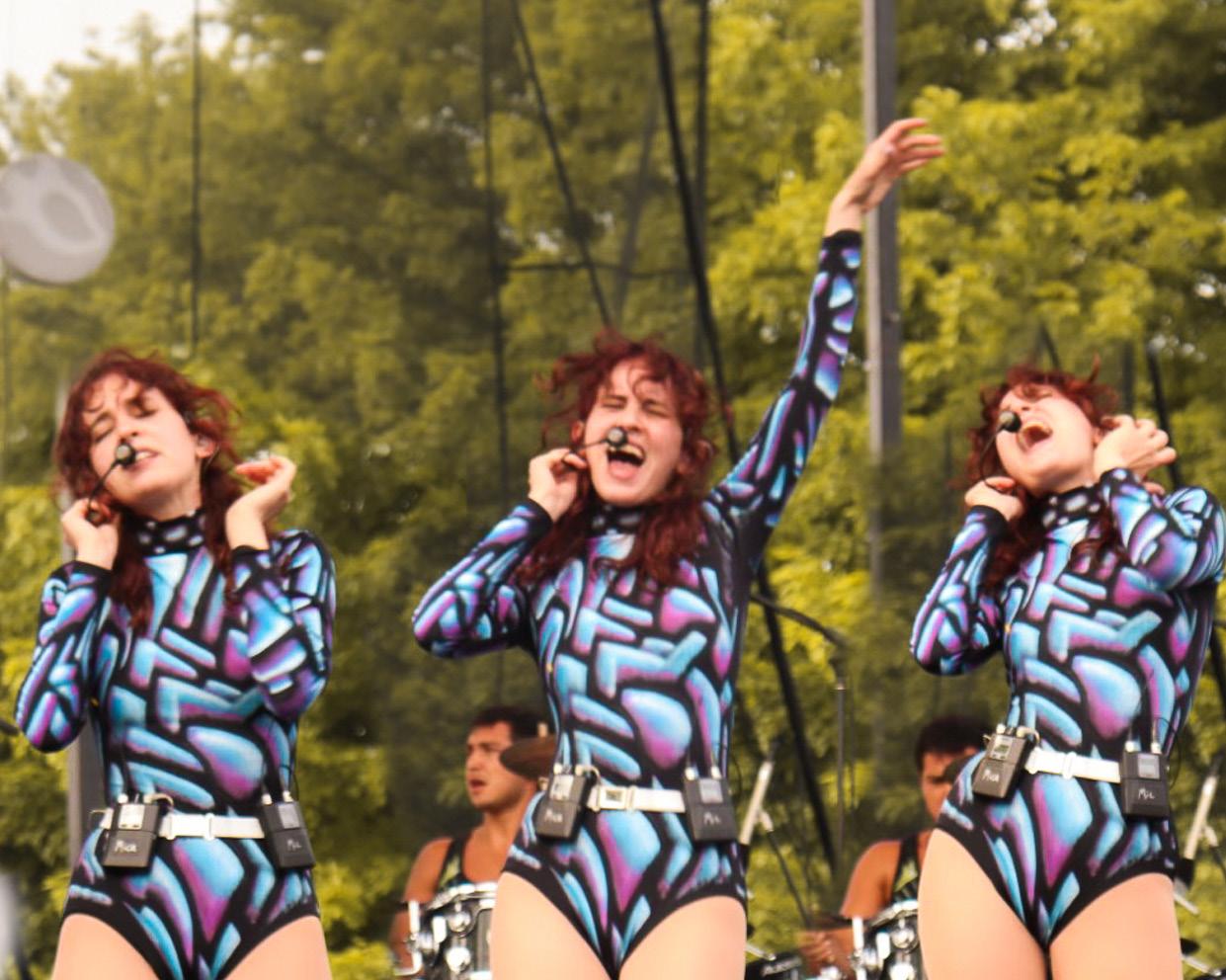

Pitchfork Fest isn’t just about the music. Pitchfork Fest is also about the little traditions you come up with while waiting in between sets, sitting in the dirt and finding good food to eat (like a deep-dish pizza, or maybe even a good falafel sandwich). Watching my friends entertain themselves with games on their phones while waiting for the next artist to take the stage was very special to me for this reason.
One thing I was absolutely not anticipating while attending Pitchfork Festival was seeing Hannibal Buress as DJ Burgerfeet in the Zelle Purple Parlor. His notso-secret secret set was packed. Standout moments include Buress freestyling during a technical malfunction and playing “The Wheels on the Bus” for Pitchfork Fest goers.

CupcakKe was the real start to Pitchfork Fest. From the moment she stepped out on stage, everyone went wild. Even being in the photo pit was insane: photographers and security were dancing, something I did not see at any other point during the festival. Her unabashed honesty was shocking, entertaining and empowering… and fun. It seemed like CupcakKe was convinced she was scaring the security guards, but she didn’t realize everyone there was having the time of their lives. She closed her set out by leading everyone in an orgiastic choir. It was crazy.


While Japanese Breakfast’s set at Pitchfork seemed like a replica of the time I had seen them at the Majestic in 2021, it was still full of surprises. Chicago staple Jeff Tweedy unexpectedly accompanied Michelle Zauner for Wilco’s “Jesus, Etc.” and Jbrekkie’s “Kokomo, IN,” two of my absolute favorite tracks. Seeing a special rendition of both songs done by Tweedy and Zauner was a chance at watching music history unfold.

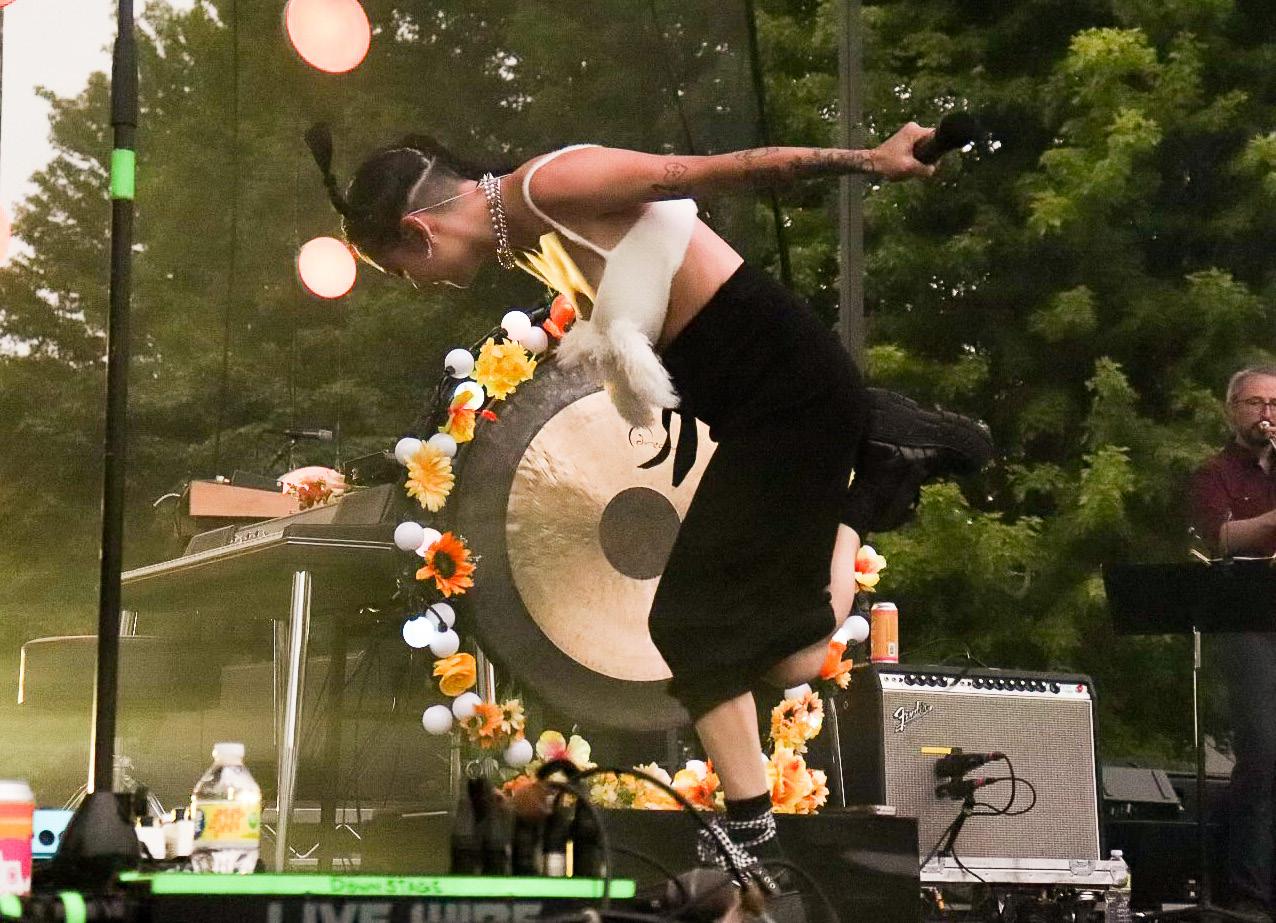
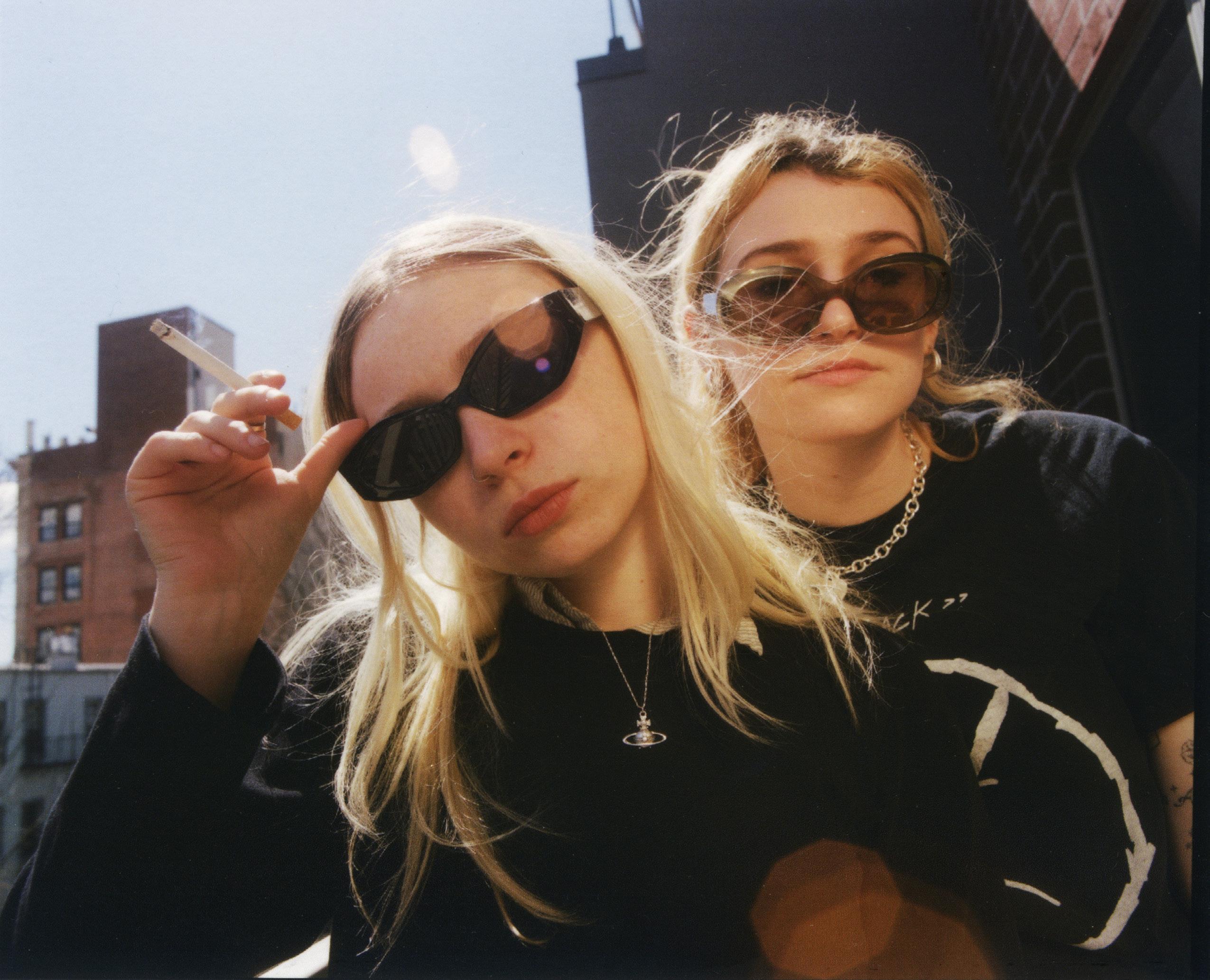
“I’ll get big, I’ll take off / And I’ll be a household name,” Momma sings on “Rip Off.” In the track, which leads the band’s latest album Household Name, members Allegra Weingarten, Etta Friedman and Aron Kobayashi Ritch yearn for fame — a level of fame where their names are known “in every home across the States.”
Opening up for Snail Mail, one of the upcoming indie rock staple’s initial inspira tions, Momma played sold-out venues to crowds of feverish fans this fall. Momma’s members bonded while touring, too, getting matching tattoos and partying after playing packed shows.
The tour supported Household Name, released at the beginning of July to near uni versal praise for its powerful hooks and choruses. Critics have compared the album to those of grunge acts like Veruca Salt and Nirvana, which has become a point of frustration for Weingarten and Friedman. If there’s anything they want people to take away from their newfound success, it’s that they’re their own band.
In August, I had the chance to speak to Weingarten and Friedman via Zoom about tour tattoos, escaping the frustration of being associated with the grunge acts of the ‘90s and becoming their very own household name.
This interview has been edited for clarity and length.
Can you both introduce yourselves?
Allegra: My name is Allegra, she/her/hers. And I play guitar and I sing.
Etta: My name is Etta I use they/them pronouns and I play guitar and sing as well.
Right now, you’re touring with Snail Mail! How has that been so far?
Etta: Literally the best tour ever.
Allegra and Etta together: It’s so fun!
Allegra: It’s really unexpected. Hotline TNT is with us too. And we are literally all like family. It’s crazy.
Etta: Yeah, we keep on saying that it feels like we’re at summer camp. And like we never want it to end. Seriously.
Aside from playing shows, have there been any super notable highlights of the tour?
Etta: For sure! There’s been so many. We do some dumb shit.
Allegra: What would you say is the highlight? Saxapahaw?
Etta: Saxapawhaw was amazing.
Allegra: We played in Saxapahaw, North Carolina, which is in the middle of no where. After the show, we were just outside in the forest for hours dancing to Lady Gaga, it was awesome.
Etta: It was so funny. We were all getting pretty trashed. Birmingham was great. In Birmingham, we played this place, The Saturn. They have this apartment upstairs, so we just had this huge slumber party. We stayed up forever. It was awesome.
That’s so fun! On Instagram, you guys posted about potentially getting tattoos together on tour. If I might ask, are you guys planning anything super special to commemorate the tour?
Etta: I’d say it’s pretty special.
Allegra: We have this phrase, I’m pretty sure I coined it.
Etta: I think you may have.
Allegra: It’s called “hang out forever,” and that’s when you just don’t want to leave someone else’s side. So I think we’re gonna get that tattooed.
Etta: Which is just such a funny tattoo in general, but we need it. Badly.
I love it! I know recently, especially with the release of Household Name, a ton of publications have been praising your hooks and your choruses. In your eyes, what’s the key to writing a catchy hook or chorus?
Allegra: Oh, that’s a good question. I think we don’t overthink it… that much. A lot of our hooks are just the first thing that we thought of. They’re meaningful because they’re pure, not because they’re deep.
Etta: Right. And on top of that, having something that’s universally understood, even if that’s secretly something super meaningful for you.
Allegra: Yeah, totally. We also listen to our own music a lot, especially when we’re writing, so if you can listen to something 10-15 times and not get sick of it, then it’s probably what you should keep.
Especially with the release of Household Name, I’ve seen a lot of people drawing comparisons between your sound and bands from the ‘90s. Do you have any more modern inspirations that you can credit for the sound of Household Name? Or do you just tend to draw more from the past?
Allegra: We’ve said this a million times before, but Beabadoobee was a really big influence for us when we were writing this record. She has a really glossy but big pop sound that we were really, really into. This is ‘90s, not grunge, but we love Frou Frou. Those were two big, really, really big influences for us that a lot of
people wouldn’t necessarily know because it’s not Nirvana.
Etta: Yeah. The grunge needs to chill.. Those bands have influenced so many other people. It’s just funny to be attached to it because we name drop. There’s plenty of other people that we listen to.
Allegra: Alex G is probably one of our biggest influences. Obviously, he’s every one’s. I feel like a lot of our guitar playing, we owe it to that guy.
Etta: Yeah, totally. And Speedy. Allegra: And Speedy Ortiz.
So do you get frustrated when people consistently compare you to Nirva na or other grunge bands?
Allegra and Etta together: Yeah!
Allegra: Maybe it’s hard to get outside of it because I’m so inside my own music, but even if I was an outsider listening to us for the first time, I don’t think it sounds exactly like Veruca Salt or The Breeders. I think we have our own style.
Etta: Yeah. I mean, those people are definitely super influential, and the Nirvana one I get a bit more. A big theme for us writing this record was studying the rise and fall of rock stars and Kurt Cobain. So I guess I understand that, but it’s just so funny.
I always love to ask bands about their local scenes and if they draw any influence from their hometowns. Where are you both from and how has that impacted your music?
Allegra: We’re from LA. A lot of people still think that we live there. We don’t, we live in Brooklyn. We were Smell kids, so we grew up in a very specific DIY commu nity with a lot of bands that were coming up, like Girlpool, Cherry Glazerr, Current Joys, Surf Curse, that whole vibe. That was also the height of Burger Records. Not that any of those are directly influences on us, but we definitely grew up around loud punk garage rock.
Etta: Yeah, it was really cool and inspiring to go somewhere in the middle of down town LA and see people who are your age or just a little bit older who go to your friend’s high school or whatever it is rocking the house down at the Smell, selling out, everyone wanted to do that.
So did you both grow up going to or playing a lot of house shows?
Allegra: Not so much house shows. The Smell was this DIY venue in downtown LA that was where everyone went. I was there three or four times a week. That was the one big one. There was a time in LA where there were just DIY spots everywhere, literally in strip malls, just random ass shit.
Etta: It was cool because those places allowed people — I mean, LA is freaking huge — it allowed kids from all different pockets of the city to meet up over one common thing. Places like the Gym, not necessarily in the center of LA, kids who lived on the outskirts were able to easily go there. Kids who lived in the center of LA would want to go there. It’s a good way to explore the city.
I’m guessing you have been asked this a ton in the spirit of your new album, but, as you gear up for your first headlining tour, and as your music is kind of picked up for more publications, I know a lot of people are kind of saying, “Oh my god, Momma is becoming a household name!” Do you want to be a household name? How do you feel about growing as a band?
Allegra: I mean, I think if we’re a household name in indie households, that would be pretty cool.
Etta: Yeah, that’d be sick.
Allegra: But we definitely don’t expect Phoebe Bridgers level household name.
Etta: Although that would rock.
Allegra: That would be epic, I would love that.
Etta: Yeah, that just comes with a lot of other territory. I mean, we’d love to, obvi ously. I feel like that’s what everyone strives for.
Allegra: I feel like we’ve been doing this for so long. We’ve been doing this since we were teenagers. To finally get to the point where we’re like, “The bands that we grew up liking are our peers now,” like Snail Mail. We saw Snail Mail in high school when Lindsey was literally 18 years old, and we fucked with it. And now we’re all hanging out. And we’re good friends.

Five years ago, you could not open a streaming service without being overwhelmed by heaps of bedroom musicians. Artists recorded songs straight from iPhones. As piring producers exchanged GarageBand for Ableton and Logic. Serum synths and ‘80s inspired drum pads were abundant. Cornerstones of the current alternative charts sparked from lo-fi bedroom pop and, five years later, the acts that dominated this scene have hit the road running. With an approach to songwriting that contains all the sensibilities present in DIY music, we are now in the era of MICHELLE.
MICHELLE is a New York collective composed of singers Sofia D’Angelo, Layla Ku, Jamee Lockhard and Emma Lee. They are accompanied by producer duo Charlie Kilgore and Julian Kaufman. The band has had a polished sound since their 2018 debut, HEATWAVE, characterized by R&B inspired harmonies, synthpop lead melodies and cozy lo-fi production.
The lyrical themes in MICHELLE’s songs are highly personal and undeniably contem porary. In the tracks, the vocalists sing about ephemeral digital-age relationships and their connection to the fast-paced New Yorker lifestyle. Each song is not only a love letter to their home, but also a glimpse into how their relationship with their hometown has changed. As the collective wraps up their first headlining interna tional tour, the Lavender Tour, these changes are as noticeable as ever.
“With that traveling comes a new perspective on New York and home, and some times new perspectives on the memories that you had there,” D’Angelo says. “I think that kind of shift, or this new sort of color, that’s come to New York from these new experiences that we’ve had affects the music in a net positive way.”
The Lavender Tour encompasses a whopping 25 headlining dates all around the US and a European leg in Britain, Belgium, France and the Netherlands. When I speak to MICHELLE, the collective has just reconvened in New York to prepare for the second leg of the tour abroad.
“You know, it used to be like Staten Island was Antarctica, you know what I mean? And Queens was LA,” Kaufman reflects. “Now I’ve traveled a little bit more and it’s expanded what the world really is for me. But when I come back to New York, it feels like home. It feels like the place I belong, but it’s not everything.”
Before their tour, the band had the chance to share their refreshing take on R&B to Mitski’s fans when they opened a leg of the cult indie sensation’s tour. The end of this summer was the first chance the artists had an extended break from their high-energy emotional performances and could focus on songwriting.
“There are two sides of you: the side that’s always traveling and the side that’s always home,” Kaufman explains. “We wrote this newest batch of songs in that alternate persona, which is, I think, what made them so kind of feel so fresh. It felt like writing songs for the first time because it felt like I was writing songs as a different person.”
“PULSE,” the first single released since their second full length album AFTER DINNER WE TALK DREAMS, is one of the tracks written through the collective’s new eyes. The song marks the start of a new era for MICHELLE, departing from their low fidelity sound towards pop stardom. While their older material felt intimate and homey, “PULSE” is vibrant, catchy and ready-made for Hot 100 charts.
D’Angelo further explains this new era of MICHELLE: “We are definitely on a quest for bangers. Whether that’s upbeat and positive or even emotional like channeling our inner rock. We really went sort of epic with our writing in August. Knowing that we’re going deeper rather than bigger is… we’ll see how it goes!”
“If we time travel back to early-era MICHELLE and we could change anything about what we’re making music we wish we could’ve had cooler shit and made cooler sounds. That’s exactly where we are right now,” Kilgore says.
While MICHELLE has narrowed down their chemistry and trademark sound over the course of their two released LPs, they still proudly wear their influences on their sleeves. D’Angelo is clearly a fan of One Direction and The 1975’s Matty Healy, and producers Kilgore and Kaufman repeatedly bring up the lore of the synthesiz ers and drum pads they acquired because their favorite bands have similar gear. D’Angelo’s take on performing carries through to the very core of the group. MICHELLE never formed with the intent of being a band. They call themselves a collective. They are a group of New Yorkers passionate about the art they have made and, through this collaboration, they have grown closer to each other and to their home city. Their first headlining tour stands as a testament to their newfound bonds as a creative family.
“My favorite moments of the tour are just relaxing with everyone… getting back to the hotel room and cracking open a beer with friends. I think that’s a real bonding moment that brings me closer to everyone else,” Kaufman says.
This new era of MICHELLE, marked by the release of “PULSE,” is here to cement the collective as a staple on pop charts. It wouldn’t be shocking if their fans become inspired by their energetic live performances and, in true DIY style, make the transi tion from fan to performer, restarting the MICHELLE cycle.
 WRITTEN BY AMANY KHREIS
PHOTO BY MICHELLE YOON
WRITTEN BY AMANY KHREIS
PHOTO BY MICHELLE YOON
Sarah Beth Tomberlin is a self-proclaimed horse girl who makes music for horse girls. The indie folk artist was raised on farms in Kentucky and Illinois by religious parents. In late 2020, she moved to New York City in the midst of writing her sophomore album, i don’t know who needs to hear this... The album was released in April of this year, produced by Phil Weinrobe, who also worked on Adrianne Lenker’s songs.
i don’t know… finds Tomberlin breaking free of her usual hushed sound: it’s loud, bold, brutal and acerbic. Her wit is as sharp as it’s ever been, and her sound has evolved in a way that can’t be ignored. You can hear her embracing New York chaos in her own horse girl way.
With her acclaimed Alex G-produced EP, Projections, under her belt and, now, i don’t know who needs to hear this..., it is clear that the Saddle Creek signed artist is only getting started.
A week before her second LP came out, I sat down with Tomberlin via Zoom to talk about how moving to Brooklyn influenced her songwriting process, kismet experi ences and the importance of feeling your feelings.
This interview has been edited for clarity and length.
I have to give it to you, I think you’re funny on Twitter. I saw the horse girl bit today.
We grew up in Kentucky during my primary years. Not only did we live on a farm with horses and cows, but I also had a barn. My sisters and I played with horses until we were probably 13. It’s undeniable who I am. It’s true. Horse girls do love Tomberlin.
So true. How has touring been? I’ve read about how, during the pandemic, you were moving around a lot and how that influenced the album. Is touring the same level of pressure as moving or is it more structured?
I feel like it’s more structured in a way because you know what your day to day life is going to be like. There are pockets of time that are open and you get to fill it, but that’s rare. I know what I’m doing every moment of every day. And there’s something reassuring about that. It is stripped away from reality, in a way.
Was Projections influenced by being shut in, or was that written prior to the pandemic?
Projections was written and recorded before the pandemic. I came off that Alex G tour then flew back to LA where I was living and, a week or two later, flew to Philly to go record it. I think we spent about 10 days or something recording half of it. “Sin” was older. It was written around the time that Weddings was written. It just didn’t, to me, go with that record and I didn’t know if I liked the song. Now, so many people love it. It’s funny how that works. I was starting to write i don’t know who needs to hear this... right before the pandemic. I think “possessed” and “unset” are probably the oldest songs on the record, but everything else is pretty new.
And how was it working with the producer who helped Adrianne Lenker and Buck Meek?
I met Phil Weinrobe when I was touring in Europe because Big Thief was also touring at the time. They used to be on Saddle Creek so they knew of me, I knew of them, but we hadn’t really met yet. On that tour, they just embraced me. One day, we were playing Primavera and then Buck [Meek] and Phil were like, “We’re gon na go eat some crazy fish, do you want to come?” I was like, absolutely! I remem bered Phil being really sweet, very communicative. You can tell he loves to learn. And I was like… noted. At first, he was just going to engineer the record and then I just was like, Phil is fully capable of doing this and I want to produce alongside him. It’s really funny thinking about someone else producing the record at this point because it wouldn’t have been the record that we made. I love Adrianne Lenker’s solo records in general, but songs especially is a comfort album at this point. I love what they captured. Phil has a really good ear for picking out things that need to be elevated. It was really fun to learn how to listen better from him.
I saw you recorded the entire album in two weeks, too. Isn’t that a bit of a time crunch?
Once we were getting into it, it wasn’t stressful. Leading up to it, you’re like, “How is this enough time?” And it worked out with the musicians we brought in because we didn’t schedule them ahead of time. I was new to the city so I knew of less mu sicians to bring in than Phil and Felix [Walworth] did. I knew that Cass McCombs was going to play on the record. I knew that my friend John from Young Jesus was going to be in town and wanted him to play on the record. We kind of just went
along as we were building the songs. Then Phil would be like, “Oh, I know this amazing piano player, David Cieri, who’s a deep feeler and would shred on a song.” We brought him in continually for the record because he was an angel. He was deeply in tune with the music. We played him “memory” and he just sobbed. Everybody who played on the record felt it. You can’t schedule that out or make that happen for someone. It just has to happen.
With moving to New York do you hear a difference in your music? Is it something that a listener could pick up on or is it personally attached to the album for you?
I think it’s probably more personal to me. People pick up on stuff that I don’t even pick up on sometimes. Songs are cool because they reveal themselves to you more over time. Even if you’re the one writing them. Songs like “stoned” and “happy accident” have a sledding, grungy kind of rock vibe. I knew I wanted them to be that way. That definitely came from wanting the aesthetic of the record to have this old school, New York, ‘70s vibe. I think there’s also city flourishes, like “tap” is definitely a combination of missing the country but trying to connect while in the city. I was only in LA a little over a year but it never quite clicked for me. It’s a beautiful place, but it’s fake, it’s not a real city, everything is spread out. New York hits you in the face and you can’t really avoid it. There’s camaraderie that’s unlike anything I’ve really ever experienced. The city shows up on the record a lot. I think there’s something kismet to living in a place like New York where stuff just happens and you’re not sure how it does.
“born again runner” is so charged. When I listened to it, it felt so personal. Was that hard to write and share with people?
It’s very hard. I was processing a recent event that had happened and playing guitar to comfort myself. I wasn’t really trying to write a song. It just started flowing. But I was also like, yikes. Really, really getting into it here. People are always like, how are your parents doing with your career? And it’s like, I am 27 years old. The purpose of the song is to be like, “look, we have extreme differences, but I want a relationship with you. You’re my family.” It’s almost taught to us to be threatened when people are different from us. It’s just a really gnarly way to exist.
i don’t know who needs to hear this... feels like an album that is there for you if you need it. What would you want people to take out of it?
The record is lighting a candle for things that have happened and experiences in this particular chapter of my life, and at the end, being like, okay, here’s this mantra to leave you with: it’s good to sing your feelings. It is good to do this thing that I did. That’s why it’s been happening for years and years and years. That’s why people do it. What I want it to be is a companion for someone who maybe doesn’t even want to fucking feel their feelings. They just want to listen to somebody else do it. And then, through that, help them engage with their own reality.

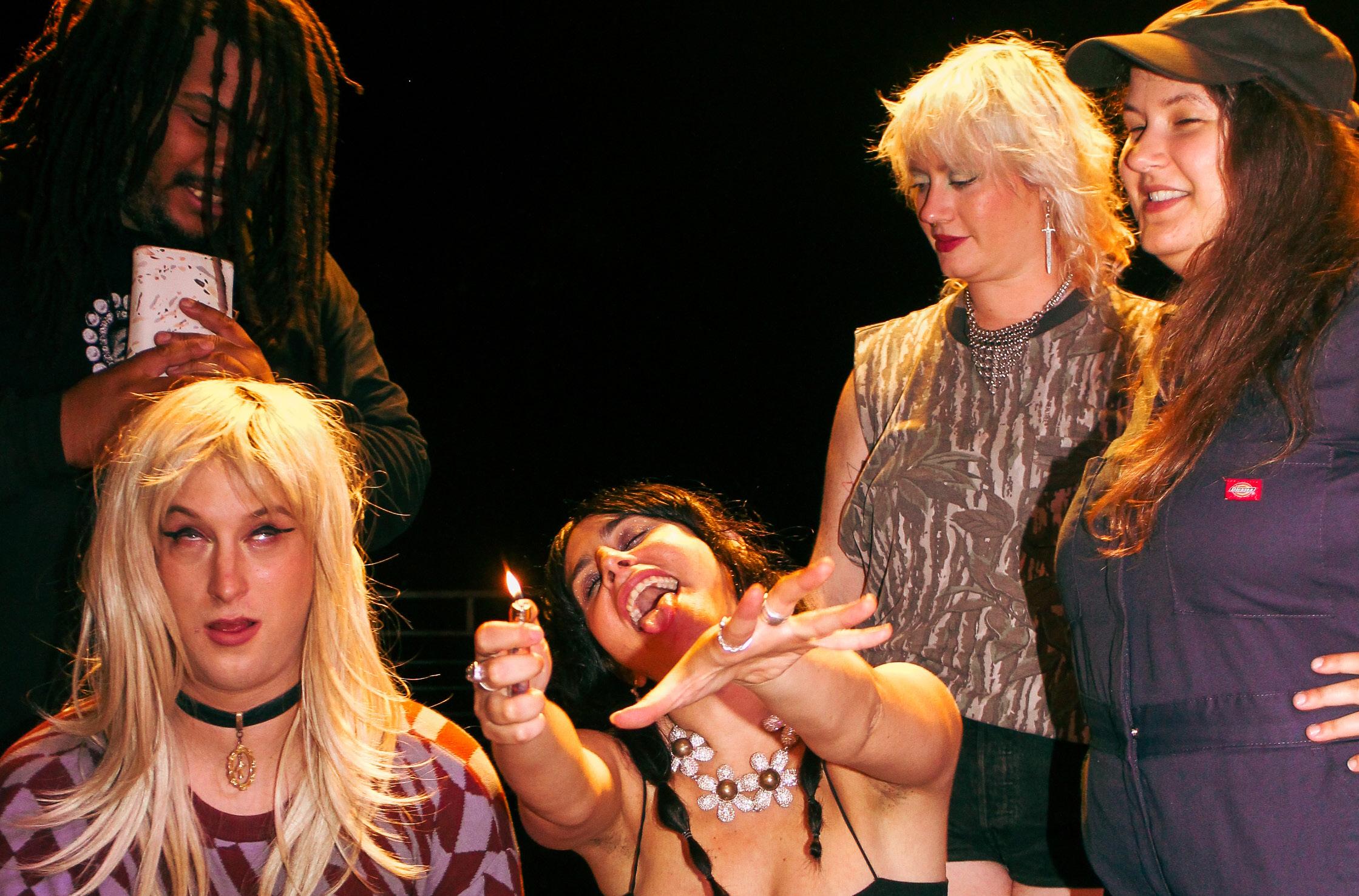 WRITTEN BY ELIZABETH WALSH PHOTOGRAPHED BY AMANY KHREIS
WRITTEN BY ELIZABETH WALSH PHOTOGRAPHED BY AMANY KHREIS
Mannequin Pussy’s Marisa Dabice walks the line between letting loose an unfiltered rage with the world and fiercely protecting her love for her craft and friends. She may look small, but Dabice has a power behind her that she will not yield for the comfort of anyone else. “I’m 5’2” with a god complex,” she joked as she joined our Zoom call from her apartment in Philadelphia.
While many consider Mannequin Pussy to be a punk band with lots of screaming and heavy instrumentals, to say that they make “angry music” is an unfair and surface level assessment. Dabice says she doesn’t write from a place of anger, rather “the anger comes more out of an exasperation or a desperateness to find catharsis.” Her lyrics are ultimately a manifestation of her acceptance for something that has happened in her life.
Dabice recognizes the excessive vulnerability that comes with her profession and she continually chooses to embrace, not run from it. She feels safer when she is honest. This has not always been the case.
When Dabice was 15, she was diagnosed with cancer. People were constantly telling her she was strong, but all she remembers is feeling like she was falling apart inside. “It took me many years to realize that I was just performing for other people’s comfort to the detriment of my own well-being,” she said.
These feelings are explored in the song “Drunk II,” which is as much inspired by a break up as it is by her experiences growing up. She sings, “And everyone says to me / ‘Missy, you’re so strong’ / But what if I don’t wanna be?”
“I was thinking about the ways in which breakups are really similar to disease,” she said. “where people want you to believe you are doing great because they can’t stand to see you as broken.”
Dabice now recognizes the emotional and verbal capacity she lacked as a 15-yearold that caused her to become “a really emotionally frozen person.” She refuses to go back to that place by continually being honest in her work and reminding us that there is no use “in pretending we are strong when we are clearly going through a hard time.”
One of her biggest struggles as an artist has been protecting herself and her body from her own emotions. “You need to make sure that your body and mind are in a really sound place so that, during a performance, when you need to access the emotions that naturally come with the songs you write, you need to be able to not let them weigh you down like they did when you originally wrote them.”
While Dabice is the frontwoman and de facto leader of the group, Mannequin Pussy plays as a five piece. Most of the time in the studio the band is made up of Dabice on vocals and guitar, Kaleen Reeding on drums and Colins Regisford – more affectionately known as Bear – on bass. On the road, they are joined by Carolyn Haynes and Max Steen on keys and guitar.
After spending just five minutes in the green room with Mannequin Pussy before their Terrace show at Memorial Union, it was clear, from all the giggles, inside jokes and loving looks being shared, that there is genuine friendship between the bandmates. The connection between them is something Dabice is well aware of. “I feel so lucky that there is so much genuine care, love and admiration between our group,” she said. “Really, at its core, that is what a band is supposed to be: a collective of creative people who are looking out for each other and are invested in each other’s well being and creativity.”
Though they share a pure love, it does not come without its challenges like with any other relationship. Right before the pandemic hit, Mannequin Pussy had just come off a grueling seven month tour and were experiencing growing pains.
“We were losing our fucking minds,” Dabice said. The band was constantly finding new ways to stay sane and look out for each other on the road. Their personalities would become what Dabice could only describe as “scratchy.” “You have to be very careful of who is in your orbit,” she said. “I sometimes feel like we are a solar system. We are all very much individuals, like individual planets, but we have learned how to orbit with each other in this really refined and beautiful way that just keeps going.”
When Mannequin Pussy takes the stage, the lighthearted smiles and giggles disappear and a powerful rage takes over. Dabice holds a reverence for the art of performing and views it as an emotional release for all the anger she accumulates day to day.
“In a day, there are probably 100 different things we could read on the news or someone could tell us that’s going to make it feel like there is a hand against our throat or someone stepping on our chest, so having a really safe outlet to literally
scream with hundreds of people is very special and I feel very lucky to have that,” she said.
There is a moment that has become a tradition at each Mannequin Pussy show. Dabice slows down, takes a deep breath and asks everyone in the audience to scream together. She knows that if there are 100 things in her life making her want to scream, there are other people feeling the same way, so why should she be the only one who gets to let it out?
Over her years as a performer she has learned that the crowd wants to be told what to do, “they want to be dominated.” The scream is how she achieves this closeness. “You are not going to be shy in this moment. We are going to make you actually hear the sound that your body is capable of making and you are going to experience how good it feels to allow that release to come out of you.”
The experience Dabice attempts to create for her audience each night is fueled by her own cravings as a fan. “When I go to a concert, I want to fucking feel it in my body. I want to feel alive. I don’t want to feel devastated.”
For inspiration she often looks to her favorite band, Turnstile. “They created something that speaks to the soul of hardcore and punk music. It feels so alive when you listen to it. I think the very essence of music is to create something that makes someone feel something, makes someone excited to move their body and be excited to be alive. I think that’s what a lot of us are chasing after.”
One might think that after an hour of screaming and jumping and wailing, Dabice would be done, that she would be tired and depleted. This is not the case. She feels alive, as though a fever has lifted and she’s finally healed. “All of us feel these aches and pains in our bodies before we go to play a show and then after we play, it suddenly feels like all the pain is gone. The rage we feel day to day has stored up in our body and that’s why it hurts and then as soon as we have this release it’s like we have no pain.”
Mannequin Pussy serves as a reminder that there is strength in honesty and power in vulnerability. You can’t keep all your pain inside. Whether you’re talking to a friend, creating art or dancing in a crowded room with a hundred strangers, it’s always better to let it out. If you hold it in, the pain will continue to accumulate. So remember: slow down, take a deep breath and SCREAM.
written and photographed by amany khreis

One of Indigo De Souza’s warmest memories is one she shares with her mother, Kimberly Oberhammer: De Souza is a toddler and her mother is helping her take a shower. Oberhammer is in the shower with her, holding her. They talk and laugh and water pools up in between them. They sit there in the water for what feels like hours sharing these moments together.
De Souza is close to her mother, both in a familial sense and a creative one. Her debut LP, which came out in 2018, is literally titled I Love My Mom. Oberhammer, an artist and painter, painted the album covers for both I Love My Mom and Any Shape You Take
Like the relationship she shares with her mom, all relationships impact De Souza deeply. Besides Arthur Russell’s music, she describes the relationships in her life as being the biggest influence on her art. “It’s just a full time job if you do it right — if you want to do it right. If you’re really working on your relationships with other people, it shows you so much. It’s the most important thing to me.” she explains.
This sentiment is echoed in every lyric of every song to the 25-yearold singer-songwriter’s name. When she isn’t navigating where relationships went wrong or why she had to step away from one, she’s embracing the people around her with her words.
In “Hold U,” a single off her latest album, she sings about wanting to hold and be held by others. The music video shows De Souza dancing with her friends in her living room. There’s warmth and closeness and safety to it. De Souza says her and her friends dance that way all the time. “Dancing is my therapy,” she says. “Whenever me and my roommates are in a good rhythm of being home, we dance almost every night together.”
In “Way Out,” the song from which Any Shape You Take gets its title, De Souza sings: “I’ll be here to hold you through the pain… I’ll be here to love you / No matter what shape you might take.”
Since De Souza has wrapped up touring, she can finally spend time with the people most important to her at home in Asheville, North Carolina. She spent a large portion of the year on the road, opening for My Morning Jacket and Mitski, playing at music festivals and performing at her own gigs.

Now, De Souza sits in her room on a video call with me, bathed in warm-toned lights and wearing an MF DOOM long-sleeved shirt. There’s a little stuffed animal in the background of the frame resting on a piano. I make a note of the sheer amounts of red and orange in her room. She tells me that the color scheme of her room is purposeful.
Indigo De Souza turns her camera around, giving me an impromptu room tour. She has red and orange cloth hanging in front of her windows, casting a warm glow onto her. Her pants are orange. Her comforter is a deep, almost-brown orange. She adds that even her living room shares the same color scheme, “Those colors are really comforting to me, really warm and cozy. I’ve always liked warm colors.”
She seems relieved as she tells me about her time at home. “When I’m gone for so much of the year, I never get to put my room together in a way that feels good, I don’t really spend any time in my room,” she says. “It’s nice to be here for long enough to have spent an idle night watching TV and drawing pictures or listening to a podcast in my room.”
There was a week in the summer where I had seen Indigo De Souza perform on three separate occasions: as an opener for My Morning Jacket, in the pouring rain at Pitchfork and headlining a college show on the Memorial Union Terrace as the sun was setting. I remind her about the Terrace show emphatically, explaining how much fun I had and how I hope she’d enjoyed it just as much.
When I provide a little more detail (I jog her memory describing the lake and the colorful chairs), she cheers up instantly, “Wow! By the lake! That show was awesome. I was nervous because a lot of college shows are really not like that — they’re actually horrible. But that was really, really fun. It was just magical. Being by the water or by trees is always magical.”
Going on tour hasn’t been the easiest for the North Carolina artist. She’s made it clear time and time again that it takes a lot of energy from her. She’s in a better place now mentally and performing old, angsty songs she wrote at a different point in her life can be draining. What makes this even harder is audiences of people completely wasted, talking over her set or ignoring her while waiting for the next band to come out.
De Souza describes this touring frenzy as having affected all artists: “We came out of the pandemic and everyone broke into a fever. Every artist I know has been torturing themselves to death because of the amount of opportunities that came through. At this point that we’re talking now, a lot of people are really burnt out.”
Touring has not only put a halt on De Souza’s recreational activities, but also impacted her songwriting process. She hasn’t been able to write much while on the road. She says making music is something that needs to be done naturally — while she tours, she’s in survival mode.
“Anytime that there is a moment to rest, I am resting and I don’t get to use my energy towards anything creative.”
She managed to fit the songwriting for her upcoming project in December of last year and wrapped up in March. The new songs she wrote came to her right after the release of Any Shape You Take, her sophomore album that’s been so dearly loved by fans and critics alike.
De Souza has been writing music for a long time, ever since she was a teenager. Like most people who do, she writes songs to process her emotions. Besides the two albums she’s released, she’s also put out work under Icky Bricketts, her side project with Ethan Baechtold.
At this point in her career, De Souza feels comfortable with where she’s at creatively and in her relationships. She describes her upcoming album (which she promises will be out sometime next year) as reflecting the current headspace she’s been in — stronger and settled. “I’m most excited to share the new album with the world because, out of anything I’ve ever made, it’s most clearly what I want to say.” Each album is completely different to De Souza. As she describes it, she was at a completely different place in her life during the making of each one.
“The first album I made, I was really young and confused and sad,” De Souza says. “I just started playing with a band and we made that album on a whim. It was magical that it ended up the way it did. The next album, I was still pretty young, but a little stronger. I had been through a lot of shit, so much trauma and pain. That album came from this place that was a little more fiery and pointed. With this new album, I came into this really great space of having a great community.”
Earlier in conversation, De Souza and I spoke about her tattoos. She told me almost all of them are stick-and-pokes that she gave herself. The tattoos done by her, on her, are her favorite ones — she feels more connected to the art on her body when it’s her own. She doesn’t see each tattoo as having a deep, emotional, grand meaning — she views each one as being a timestamp in her life. Something permanent on something temporary.
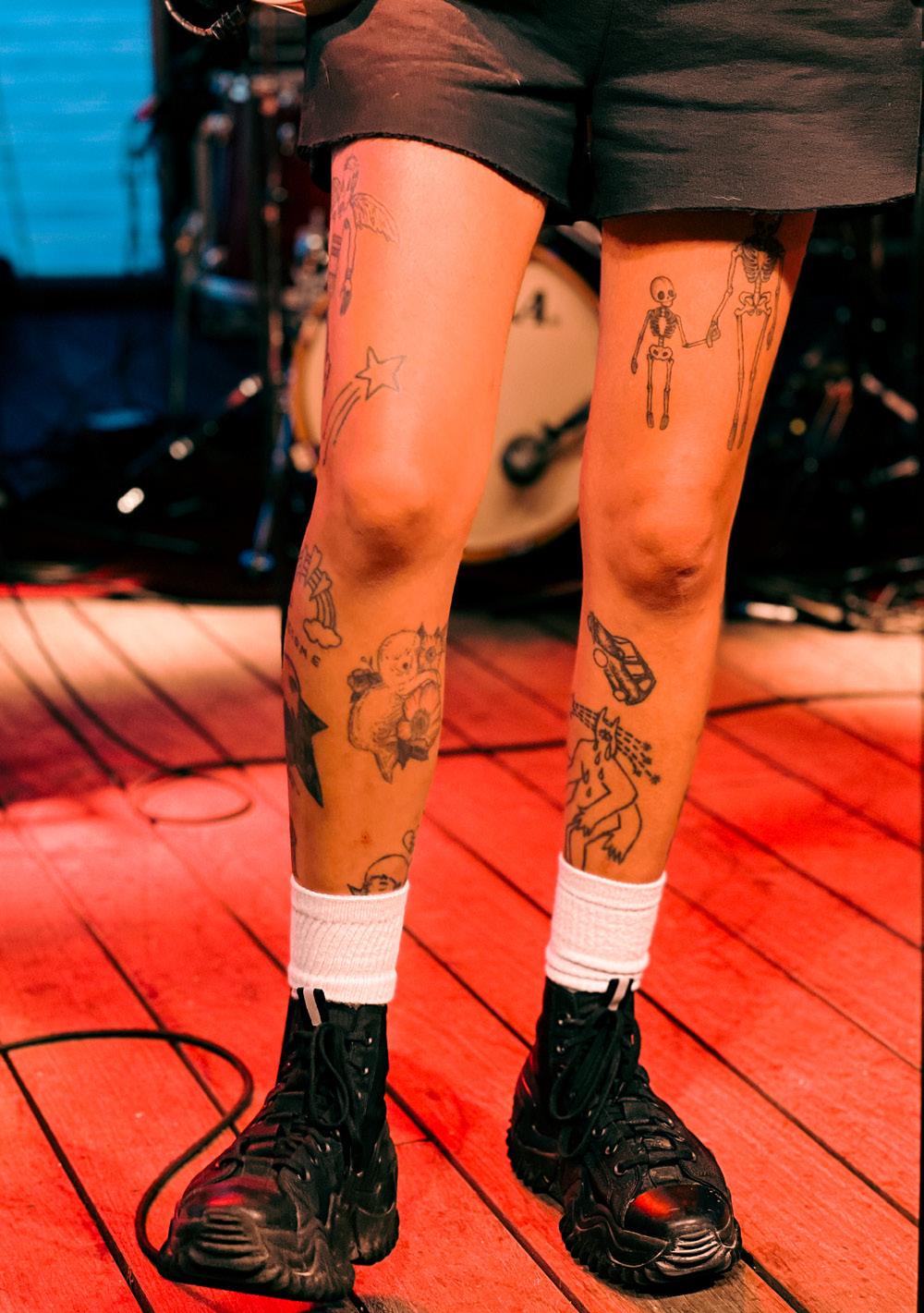
“I feel connected to my body, but I’m very aware of how my body is not really myself. Tattoos helped me feel more at peace with that and closer to my body.”
De Souza views her albums in the same way: “I really love sequencing albums. It feels like a story. It’s kind of similar to tattoos, right? It just feels like a timestamp. Each album is this moment in my life and my life is never the same in every moment. It’s definitely going to sound like each song will have its own mind.”
On this new album, this holds true. She’s dabbling in new sounds and new genres. She had fun exploring where her music could go on her sophomore album with songs like “17” and “Die/Cry.” Making new sounds is fun for De Souza. It makes her feel like she’s on a playground.
I ask De Souza about how she came to be so sure of her relationships. She answers by saying the key is knowing when to leave and realizing that you are an individual first before you are a partner in a relationship.
“Okay, so I’m a person and you’re a person,” she begins explaining. “And the way in which we’re growing right now is not allowing us to be together as partners, but that doesn’t mean that we can’t remember the time we shared and continue to love each other in a different way. You still shared so much love with that person. If they’re trying to grow and better themselves, and they have to be away from you to do that, then that’s a great thing.”
De Souza learned that she had to be accountable for her own emotions. That, if someone hurts you, it’s your responsibility to work through your own emotions that boiled up in reaction to the pain. It’s your responsibility to separate yourself from certain relationships and it’s your responsibility to surround yourself with other relationships.
That’s where Indigo De Souza is at right now: confident, comfortable and resting. She dances with her roommates every night. She hangs out with her two baby nieces. She spends time alone, resting in her room, doing nothing at all. Now, she gets to unwind.

“I’m
ever made, it’s most clearly what I want to
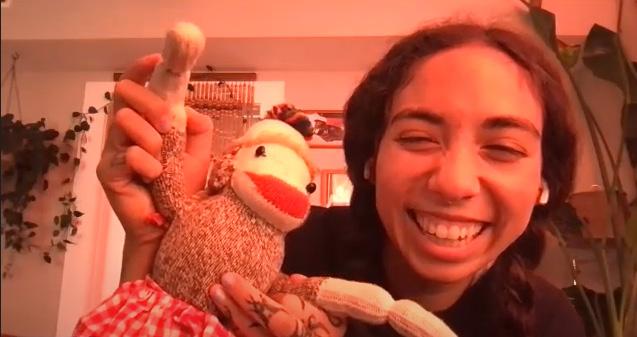



I oftentimes passively tell people about how I could never actually meet the mu sicians I adore the most. I know I would burst into tears and the only thing that would come out of my mouth would be hysterical sobs. Of course, this sort of deranged behavior hasn’t happened yet — and I don’t believe I’ll find myself in this situation soon. I work with musicians I’m a fan of a lot, but it is rare to connect with a musician on an unspeakable level. Taylor Swift is one artist I don’t believe I could ever meet. I have been listening to her music since 2006, when she first rose up to the scene with teardrops on her guitar, lyrics written on a note napkin and stupid old pick up trucks. I haven’t been able to shake her since. I cried when she followed my Tumblr blog at 12 years old and then again when she liked my selfie at 17. To have someone be intertwined in your life for that long is disillusioning in the best way. I feel the same way about Fiona Apple. I started listening to her when I was in high school and stumbled upon “Every Single Night.” Ever since, I have connected with her words and quirkiness so intensely that I decided on “DJ Appletinii” for my DJ name. I feel this same level of intensity with longer reigning artists, both dead and alive, like Leonard Cohen and Joni Michell. With music you love dearly, it is best to steer clear from the ones who made it.
Amany KhreisFor the last four years of my life, I have been notoriously obsessed with Harry Styles. No matter who I met or spoke to, the first comment I would receive would in some way involve the musician — “You’re the one who loves Harry Styles, right?” I would surround myself with individuals who shared my interest in his music, his style and everything in between. On one particularly chilly November day, my friend and I were set to attend the Milwaukee show of his sold-out 2021 Love On Tour. We had been anticipating the show for not just months, but years. We went to bed side by side at about midnight, having set an alarm to blare “Diana” by One Direction at 3:30 a.m. We arrived at the venue at 4:00 a.m. to meet the many fans who had already begun camping outside for a good spot in the pit. After setting up our sleeping bags and pillows, we introduced ourselves to those around us. They all expressed the same hesitance that we had been experiencing: that feeling of, “are we crazy for doing this?” The answer was, of course, yes. Regardless, we had the best 17 hours of sharing food, stories and burnt-out hand warmers. Being around such an undeniable atmosphere of shared love for an artist was powerful and it made me feel grounded in my own passion for music.
Athena KafkasIn almost a rite of passage, there comes a time in every middle-school girl’s life from the mid-2010s to decide who their blatant musical obsession would be. Were you going to be a Belieber or a Directioner? Maybe an Arianator, or part of the BTS army? I found myself at a crossroads of outright rebellion against mainstream boy bands and the strong desire to still “stan” a specific musician. Thus began my very first work of stan culture: the multi-talented mu sician Bruno Mars. With blatant sexual innuendos in songs like “Gorilla” and “Locked out of Heaven” going right over my head, Bruno Mars was my earliest obsession at the age of 13 years old. From seeing him live in concert with my mom in St. Louis to hanging a poster of him on the ceiling of my childhood bedroom to opening a specialty fan Instagram account, Bruno Mars taught me the meaning of fan culture and being a “stan.” Never before had I owned such an excessive amount of merch, memorabilia and general decorations focused around one celebrity. As time passes and interests evolve, I don’t regret a thing about the experience. Through countless album releases, a Super Bowl halftime show and continued success as one half of the duo Silk Sonic, it is a rewarding feeling to have followed Bruno Mars from the beginning.
Saffron Mears
Seeing Sufjan Stevens live is like a rite of passage for really annoying people — on each tour, he’s somehow able to showcase every album’s best aspects in a ridiculous way. While touring during the Age of Adz era, Stevens donned neon outfits and choreographed massive dance numbers to the album’s soaring electronica tracks. In support of Illinois, he wore wings and enlisted the help of a large band he dubbed the Illinoisemakers. And on his Carrie & Low ell tour, he dove into the album’s heart-wrenching indie folk, crying throughout his sets only to inexplicably end by covering Drake’s “Hotline Bling.” But there’s one problem (at least for me): he hasn’t performed live since 2018. I got into his music shortly after his Carrie & Lowell tour ended. As a freshman in high school in the middle of the Chicago suburbs, his album Illinois helped me appreciate my distressingly mundane hometown. Since then, I’ve been in love with his discography, but I’ve never been able to tape a Sufjan ticket to my wall or show off a setlist I snagged. He’s incredibly prolific, too, and he’s released five albums since his last show, with each one making me yearn for a tour more and more. Unless he’s avoiding touring because of Covid, it’s hard to stan an artist who I can’t see live. Sufjan, it’s been over six years since you’ve had a show in the midwest… please :-(
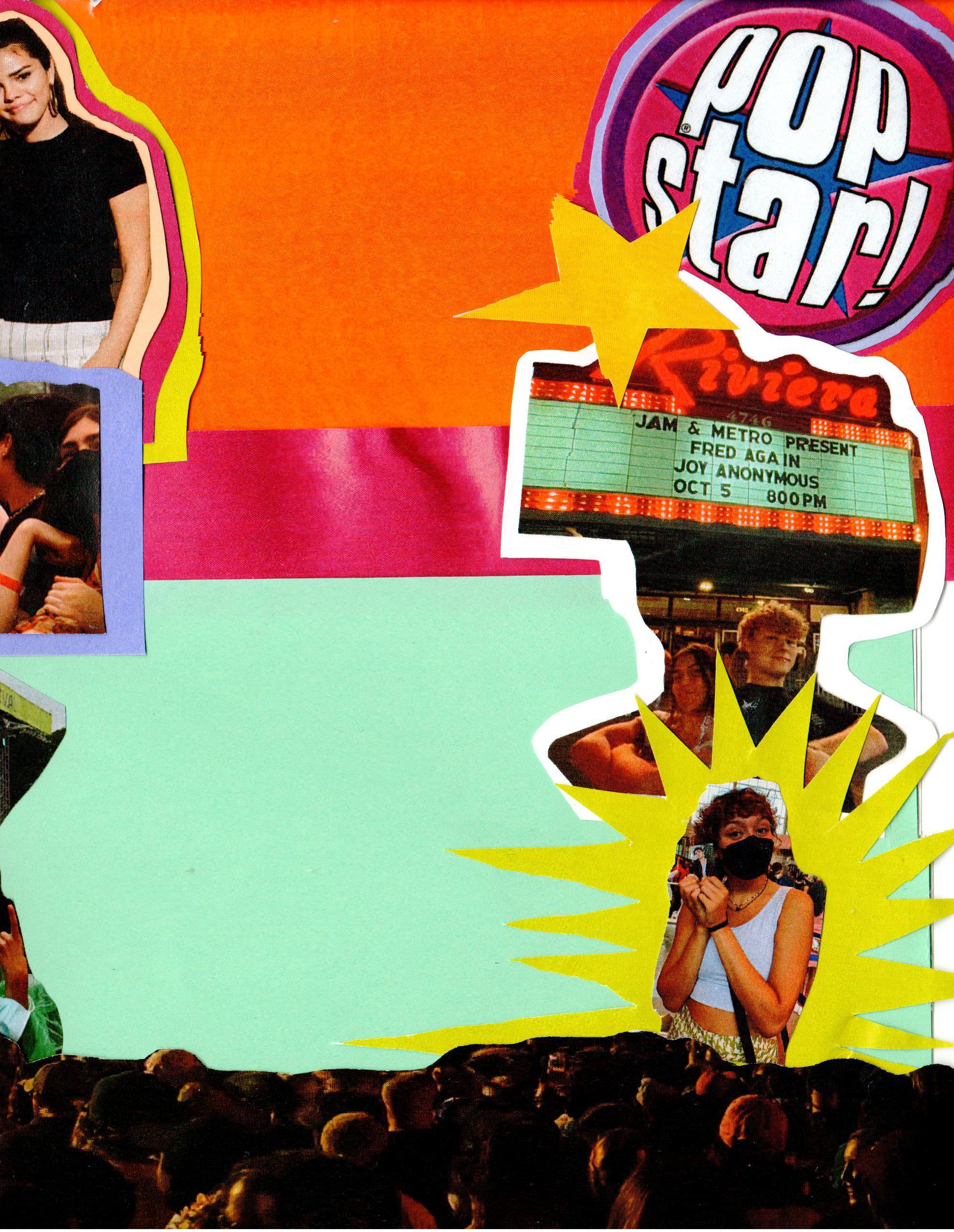 Amelia Zollner
Amelia Zollner
I hate the word “stan.” I never really understood people that were completely and utterly obsessed with one artist. I can call myself a “stan” with some foods (peanut butter) or a movie (“Hoodwinked”) but I don’t think I’ve ever loved a musician that much. I never got the love of Taylor Swift or the Jonas Brothers like my friends or sister did. However, when Omar Apollo released his latest album Ivory, I accepted that I had to “stan,” even if the word makes me cringe. I have been an Omar Apollo fan since 2017. “Breaklights” and “Ugotome” got me through my freshman year of high school. “Kickback” played while I went on cross-country training runs. I shook my house as I jumped around to “Useless.” Every year, there was a new song, and I ate it all up. Ivory reiter ated this love again and again. I truly think it’s his best album yet. He brings an energy to his songs, with his range of style, lyrics, their danceability, that I haven’t found in any other artist. When I listen to “Talk,” my favorite track, I scream and dance and cry all at once. I listen over and over. My love of his songs isn’t just a phase. I keep coming back to his first release, Ugotome and I love it as much as I did in 2017. I don’t feel that way about any other artist. Omar’s the only artist I could ever “stan”.
Britta WellensteinIn March of 2021 in a COVID-ridden dorm, me, my best friend and three people I didn’t know sat down to watch Harry Styles perform at the Grammys. Needless to say, his iconic leather jacket and neon green boa induced screams so loud the RA five doors down came to tell us to keep it down. Little did we know that sticking around to watch a seven-member group perform their hit song “Dynamite” would change the course of our lives and friendship forever. As odd as it sounds, BTS helped me find some of my closest friends and sent all of us spiraling into a K-pop frenzy for the years that followed. That summer, we talked about nothing but K-pop. Even living on opposite ends of the country, we would stay connected by sharing album unboxing videos, sending TikTok edits and facetiming to watch music video drops at 3 a.m. When the five of us moved into one apartment, we plastered the walls with posters of our favorite bands, collected every piece of memorabilia we could and became known as the “K-pop house.” Our infamous BTS cold brews and Jungkook doll became a staple that all our friends and family knew about and everyone was excited to see that we finally got tickets to a K-pop concert. I often feel abso lutely crazy, especially with the stan culture surrounding K-pop, but becoming a fan is one of the reasons my friends and I are so close, so call me crazy.
 Elizabeth Kallies
Elizabeth Kallies
I can still clearly remember dancing to Taylor Swift’s “You Belong with Me” music video in my pajamas at six years old. Throughout my childhood, I ab solutely adored Taylor Swift’s music. However, as I got older, I slowly grew out of her music. My love for Swift returned in my junior year of high school. She was an easy artist to put on with friends. Slowly, several members of my friend group got more involved with her music, and in turn, her fanbase. Taylor Swift is just as well known for her fanbase as she is for her songs. The “Swifties” are particularly notorious for their outlandish theories, from picking out the most minuscule details in her music videos, creating mathematical formulas from her release dates and picking apart every word of her interviews, I have seen peo ple use every possible method to convince others that a new album is about to be released. Despite the sometimes insane discourse in the community, they make listening to her music much more interesting and lively.
 Logan Underwood
Logan Underwood
 KING PRINCESS PHOTOGRAPHED BY CLAUDIA CHAN
KING PRINCESS PHOTOGRAPHED BY CLAUDIA CHAN
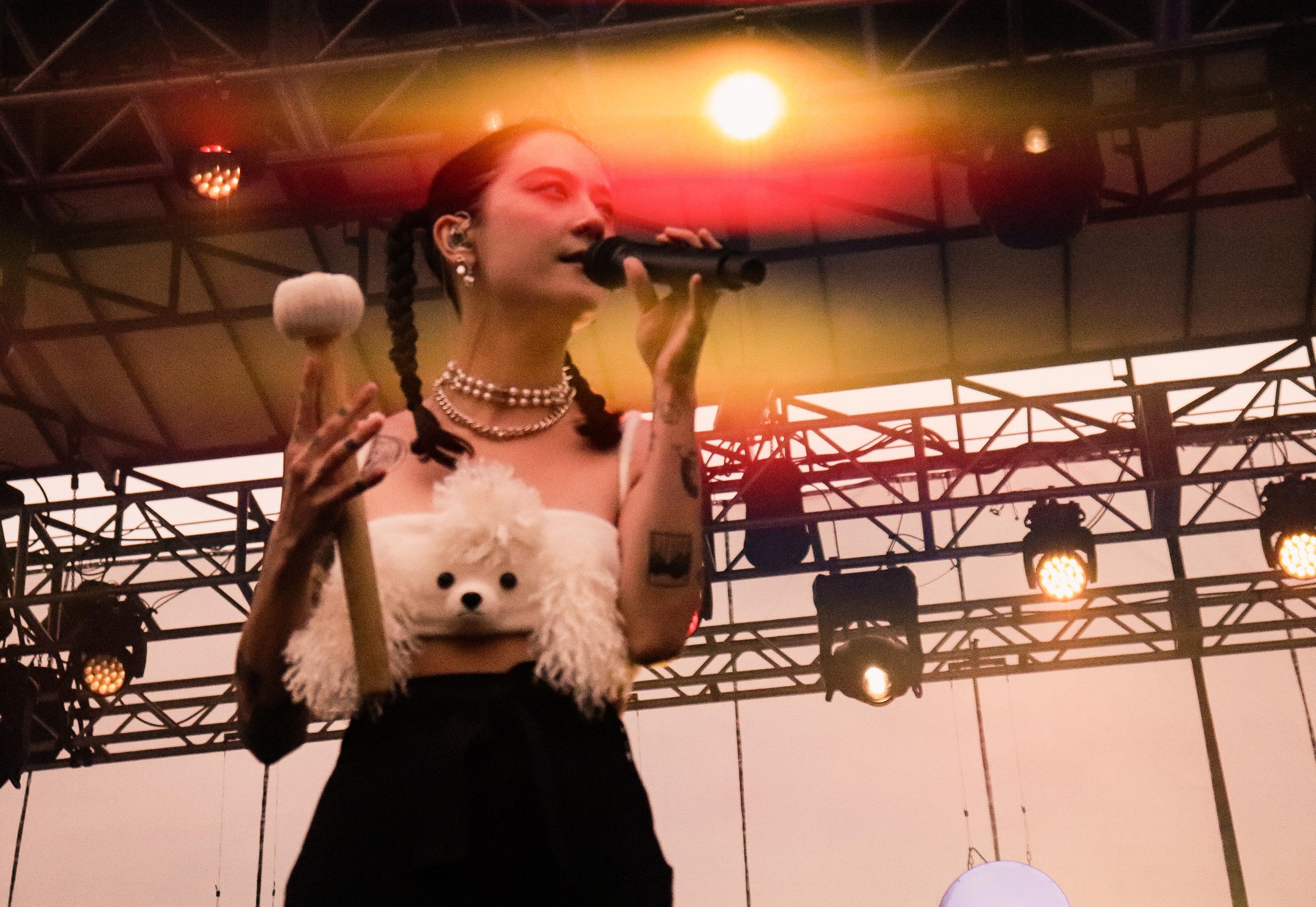





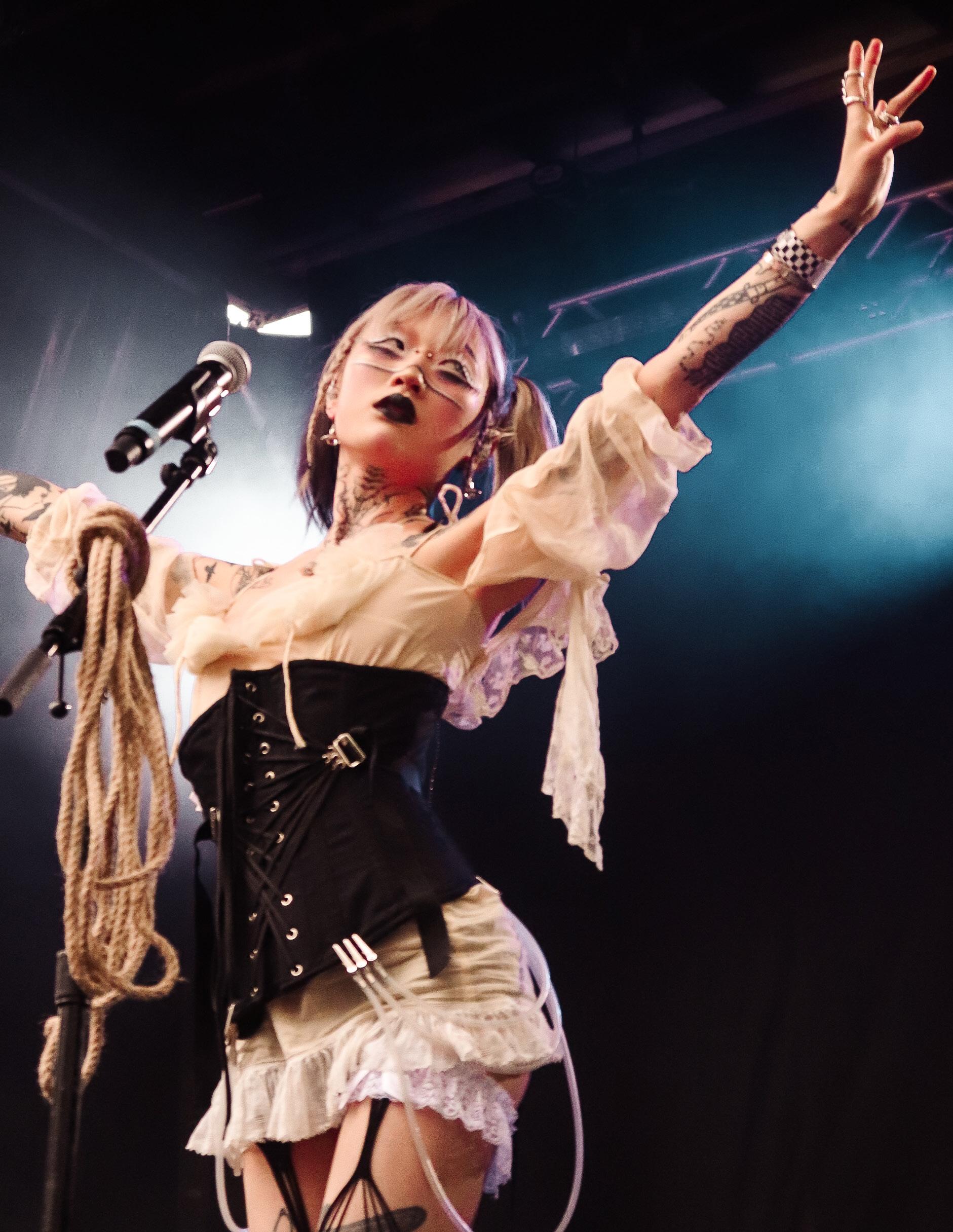 YEULE PHOTOGRAPHED BY AMANY KHREIS
YEULE PHOTOGRAPHED BY AMANY KHREIS
Through the publishing of our four student-run journals and magazines, the Publications Committee of the Wisconsin Union Directorate provides a creative outlet for UW-Madison students interested in creating poetry and prose, reporting on music or delving into food and travel. We celebrate creativity on campus by providing hands-on experience in publishing, editing, writing and design.
